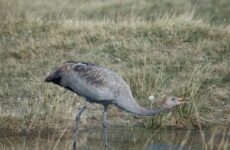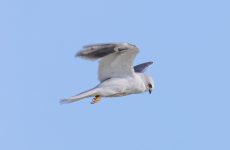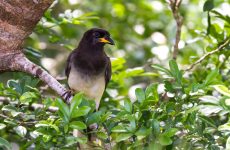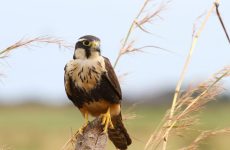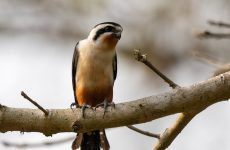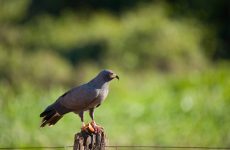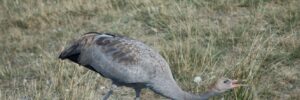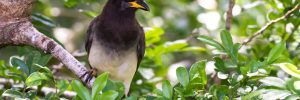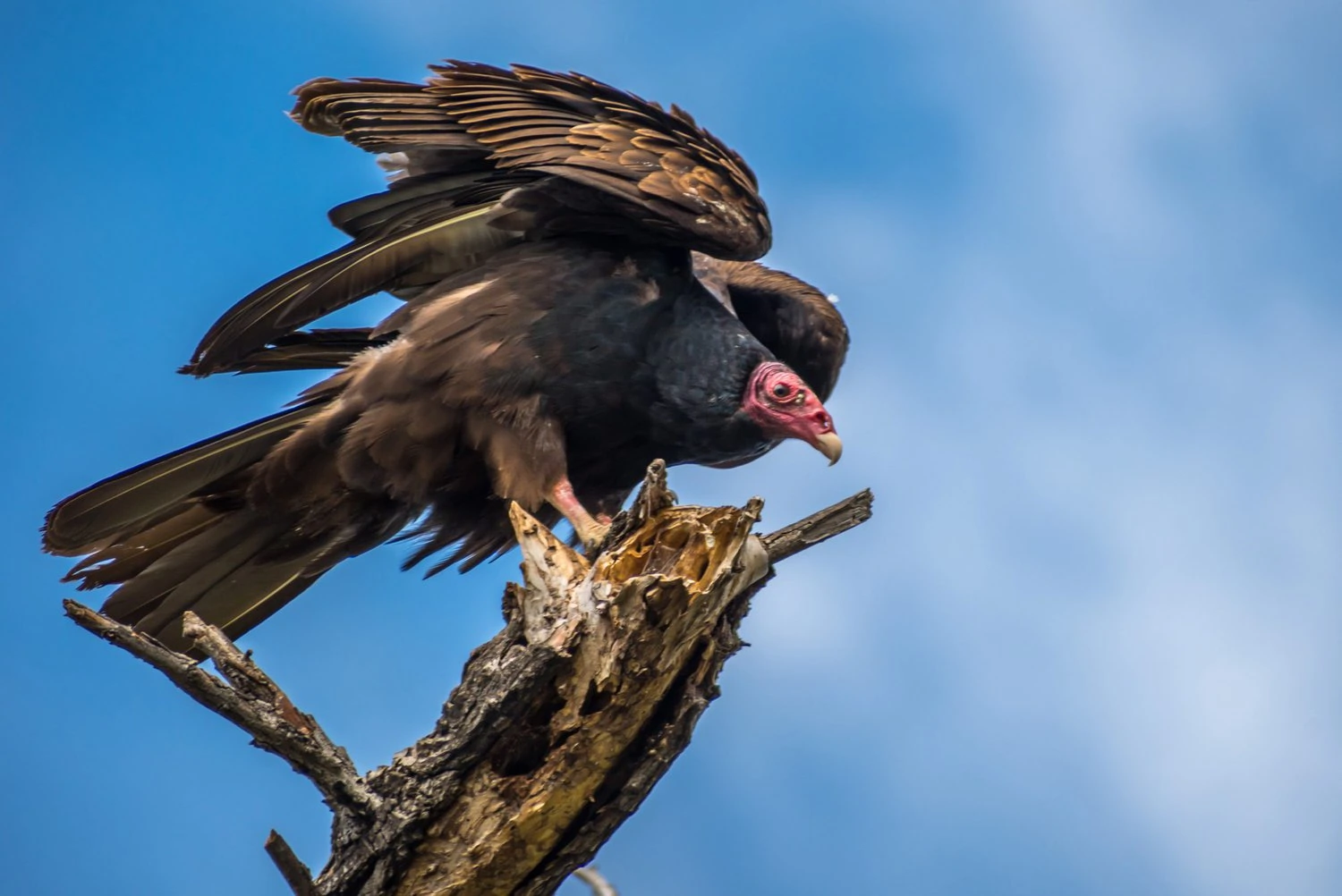
Whether you are backyard birdwatching or out on a hike these are the most common birds that you will see in winter in Texas.
How many have you spotted?
25 Common Winter Birds Texas
1. Northern Cardinal
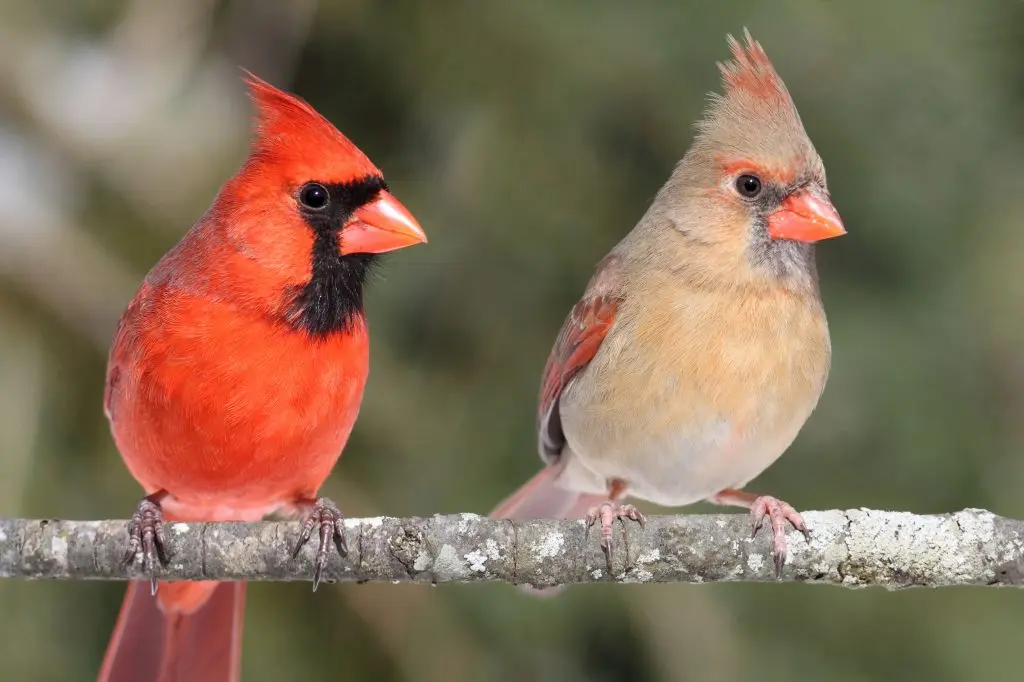
The bright red male Northern Cardinal with black around their faces is an incredible sight, especially against a white winter background. They also have red crests and beaks.
Females are also a little showy with their brown coloring, sharp brown crest, red highlights, and red beaks.
- Cardinalis cardinalis
- Length: 8.3-9.1 in (21-23 cm)
- Weight: 1.5-1.7 oz (42-48 g)
- Wingspan: 9.8-12.2 in (25-31 cm)
Northern Cardinals live in the Eastern half of the US and some states in the south as far west as Arizona.
You can find Northern Cardinals in dense vegetation foraging for seeds, fruit, and insects. Northern Cardinals will sometimes attack their own reflection during the breeding season as they obsessively defend their territories.
Northern Cardinal Song:
Northern Cardinal Call:
Attract Northern Cardinals to your backyard with feeders full of sunflower seeds, peanut hearts, millet, and milo. They will feed from large tube feeders, hoppers, platform feeders, or food scattered on the ground.
2. Northern Mockingbird
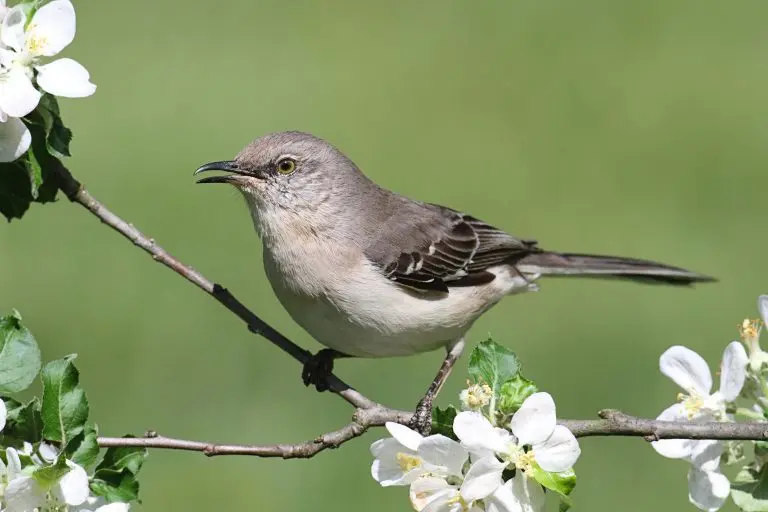
Northern Mockingbirds are medium-sized songbirds with small heads and long tails. They are a gray-brown color and slightly paler on the underside than their back, and they have two white wingbars visible in flight.
- Mimus polyglottos
- Length: 8.3-10.2 in (21-26 cm)
- Weight: 1.6-2.0 oz (45-58 g)
- Wingspan: 12.2-13.8 in (31-35 cm)
Northern Mockingbirds do not migrate and can be spotted across the lower 48 and southern Canada.
They are usually seen alone or in pairs and aggressively defend their territory. A male mockingbird can learn around 200 songs in its life, copying other birds’ songs, and they can sing all through the day and into the night.
Northern Mockingbird Call/Song:
Attract more Northern Mockingbirds to your backyard by planting fruiting trees or bushes, including hawthorns, mulberries, and blackberry brambles. They don’t often visit feeders, but they will come to open lawn areas.
3. Yellow-rumped Warbler
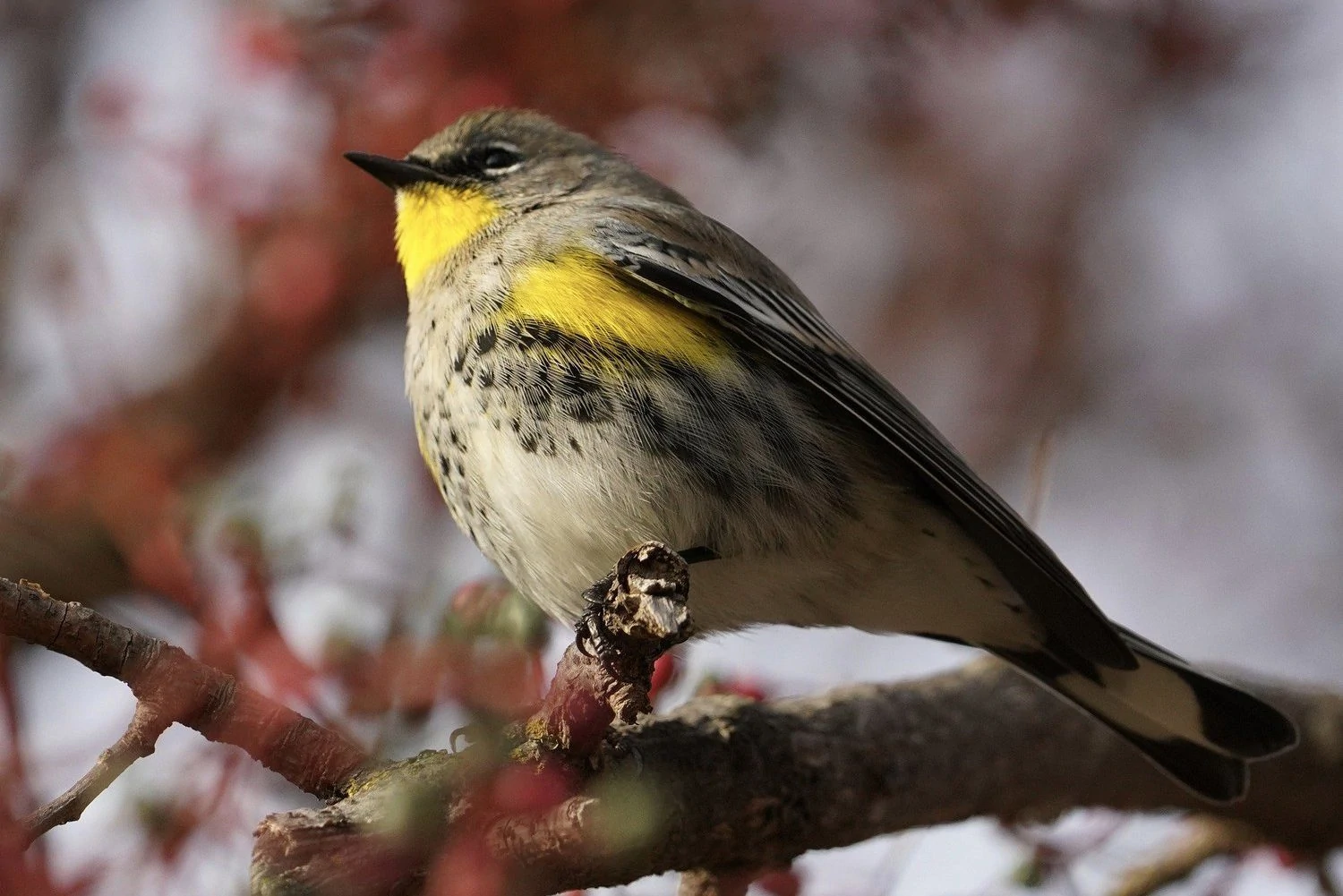
Yellow-rumped Warblers are gray with flashes of yellow on the face, sides, and rump and white in the wings.
Females may be slightly brown, and winter birds are paler brown with bright yellow rumps and sides turning bright yellow and gray again in spring.
- Setophaga coronata
- Length: 4.7-5.5 in (12-14 cm)
- Weight: 0.4-0.5 oz (12-13 g)
- Wingspan: 7.5-9.1 in (19-23 cm)
Yellow-rumped Warblers breed predominantly in Canada and parts of the Rockies and the Appalachian mountains.
During migration, they can be seen in the Midwest before overwintering in southern and southwestern US states and the Pacific Coast and into Mexico and Central America.
You can find Yellow-rumped Warblers in coniferous forests, especially during the breeding season. During winter, they can be found in open areas with fruiting shrubs. In summer, they eat mostly insects and on migration, and in winter, they eat mostly fruit, including bayberry and wax myrtle.
Yellow-rumped Warbler Song:
Attract Yellow-rumped Warblers to your backyard with sunflower seeds, suet, raisins, and peanut butter.
4. Turkey Vulture

Turkey Vultures are aptly named. They do look like turkeys with their big, bald, red heads and upper necks and brownish-black bodies. However, they are larger than turkeys, and when they’re in flight, their broad wings are slightly raised and make a “V”.
Under their wings, they have gray coloring, making it seem like they’re two-toned. Their eyes are dark brown, and their bills are light-colored.
There are a total of 6 subspecies of Turkey Vultures, and three of them are in North America, which is why they are sometimes classified as “Northern” Turkey Vultures. There are only minor differences among them, mainly tail and wing proportions and color in the underwing feathers.
- Cathartes aura
- Length: 26 – 32 in (66 – 81 cm)
- Weight: 51.2 oz (1451 g)
- Wingspan: 68 – 72 in (173 – 183 cm)
You can find Turkey Vultures in a wide range of habitats, but the most common is open and semi-open areas next to woodlands. They need open areas, like grasslands, shrublands, deserts, and wetlands for foraging. They also need forests with high trees for nesting and roosting, and they need middle to high elevations, like hills and mountainous areas, to give them a height advantage for taking flight.
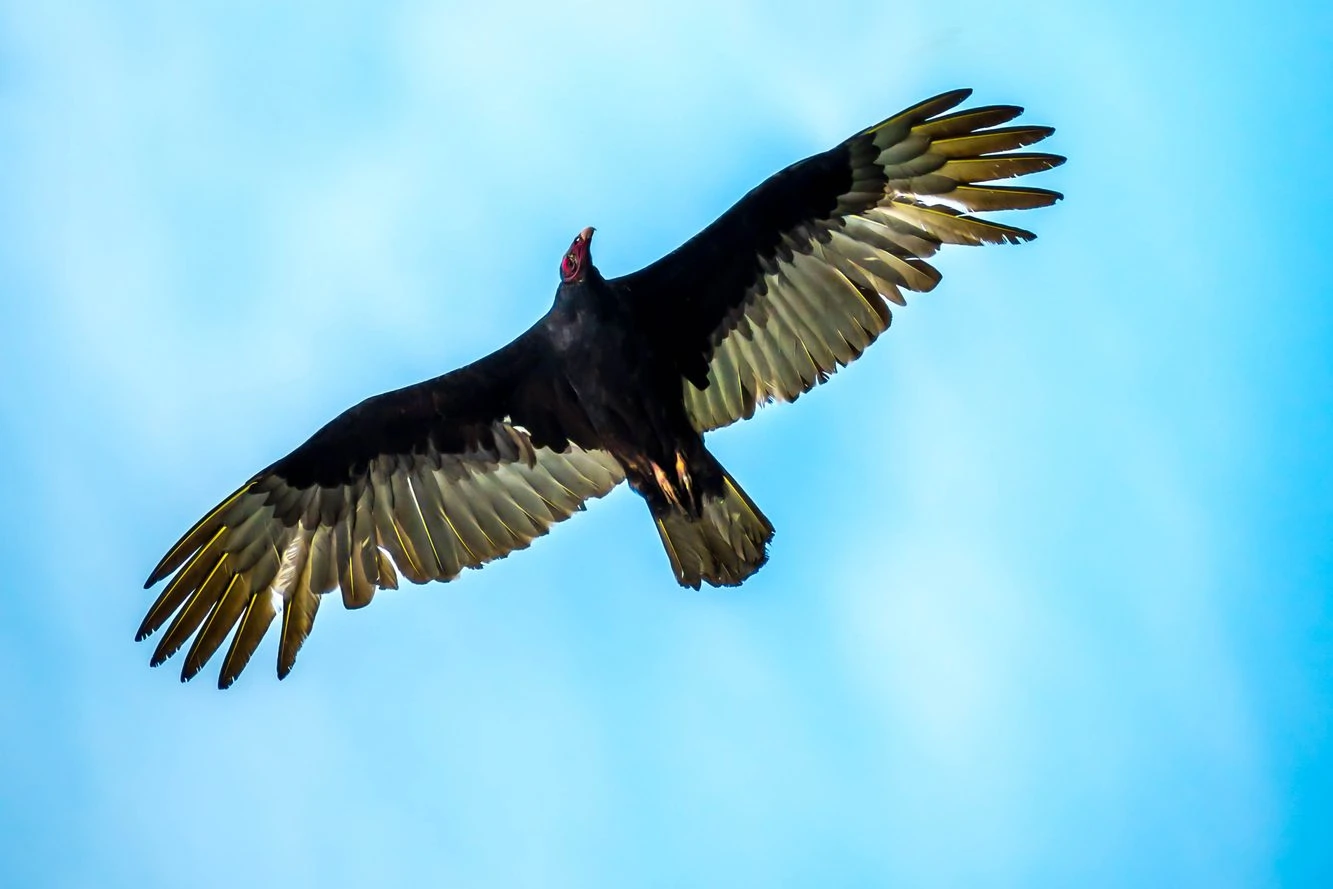
Sometimes, they will also venture into farmlands or pasturelands for foraging and roosting. Human-made structures are also taken over by them when they’re in urban areas, but only if they can’t find their preferred habitats.
Turkey Vultures’ main source of food is carrion or recently dead or decaying animals as long as it hasn’t decayed too much. They may feed on roadkill and washed-up fish and may even kill small or weak animals.
Turkey Vultures calls: They can only make a raspy hissing sound, but are usually silent.
Fun Facts: The sense of smell of Turkey Vultures is quite strong and they’re able to detect odors of decaying or dead animals on the ground from great distances.
When Turkey Vultures are threatened or aggravated, they will vomit to provide a distraction and fly away. They may even pretend to be dead.
5. Mourning Dove
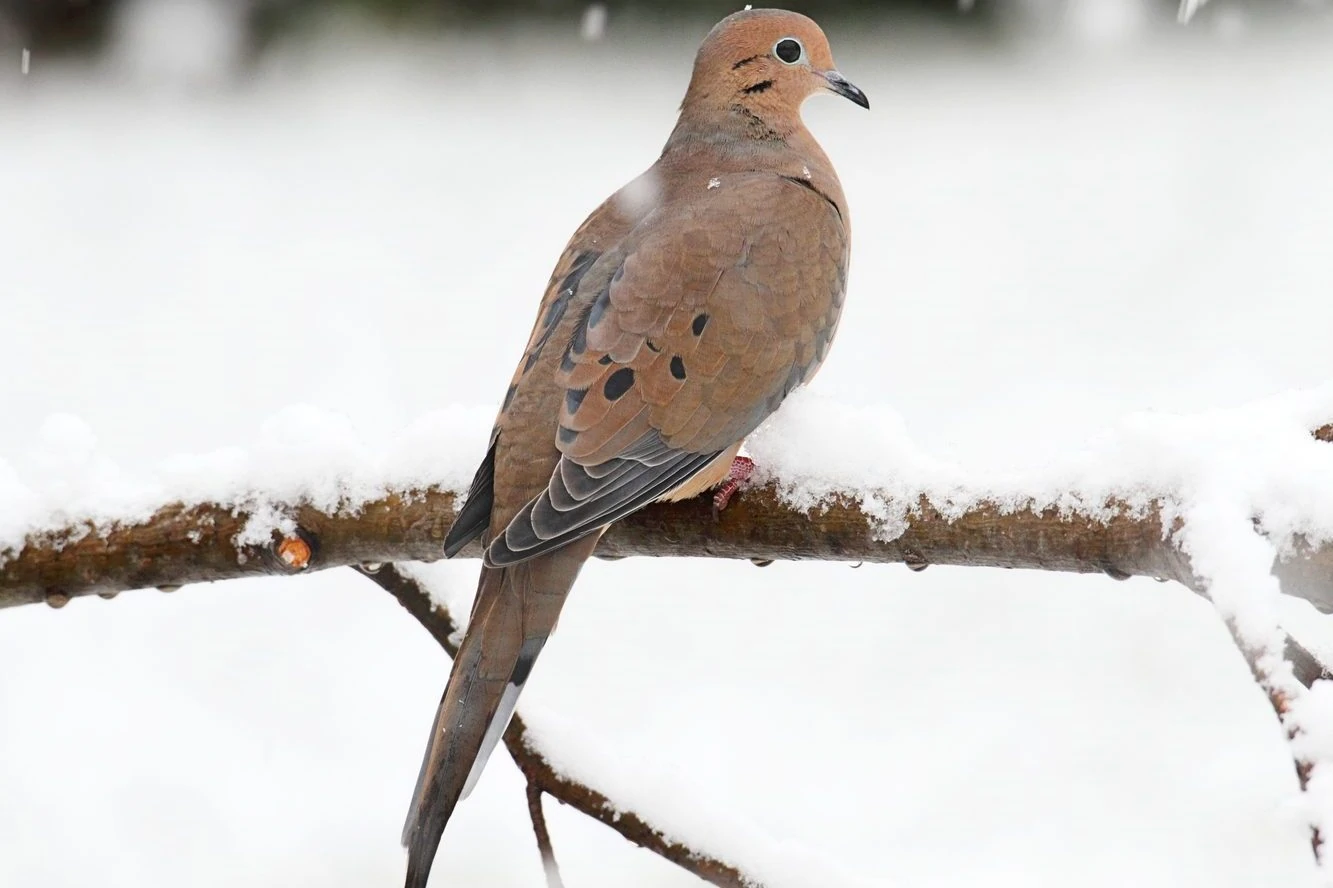
Mourning Doves are graceful small-headed birds with plump bodies and long tails. They are a soft brown color with black spots on the wings. Males are slightly heavier than females.
- Zenaida macroura
- Length: 9.1-13.4 in (23-34 cm)
- Weight: 3.0 -6.0 oz (96-170 g)
- Wingspan: 17.7 in (45 cm)
Mourning Doves are common over all of the lower 48 all year but may migrate after breeding from the north of the Midwest and southern Canada.
Mourning Doves can be seen perching on telephone wires and foraging for seeds on the ground in grasslands, fields, and backyards. They can also be found in open areas or woodland edges.
Mourning Dove call:
Attract Mourning Doves to your backyard by scattering millet on the ground or platform feeders. They will also eat black sunflower seeds, nyjer, cracked corn, and peanut hearts.
6. Ruby-crowned Kinglet
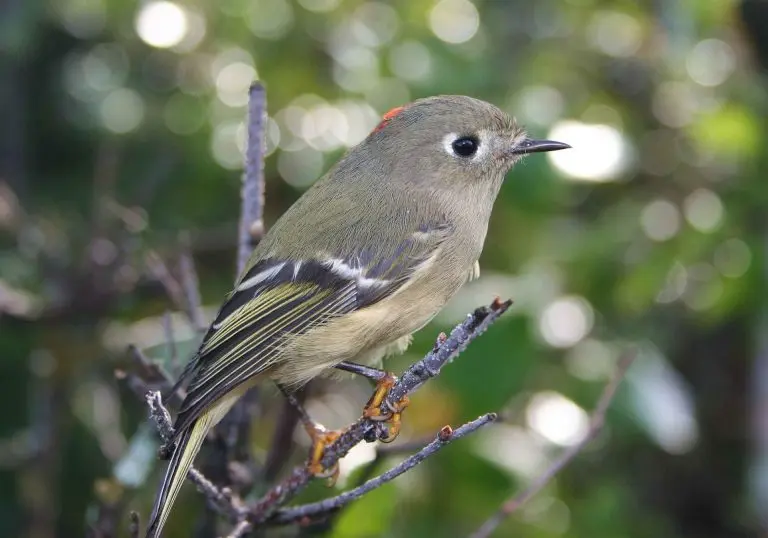
Ruby-crowned Kinglets are small songbirds that are olive-green, and the males have a brilliant red crown that is usually flat, so hard to see.
- Corthylio calendula
- Length: 3.5-4.3 in (9-11 cm)
- Weight: 0.2-0.3 oz (5-10 g)
- Wingspan: 6.3-7.1 in (16-18 cm)
Ruby-crowned Kinglets breed in Canada and the mountainous west before migrating to southern and southwestern US states and Mexico for the winter.
Ruby-crowned Kinglets can be hard to spot as they are fast-moving quiet birds that flit around in the foliage of lower branches and shrubs and trees looking for spiders and insects.
Ruby-crowned Kinglet Song:
Attract Ruby-crowned Kinglets with suet or platform feeders with hulled sunflower seeds, peanut hearts, and mealworms.
7. Carolina Chickadee
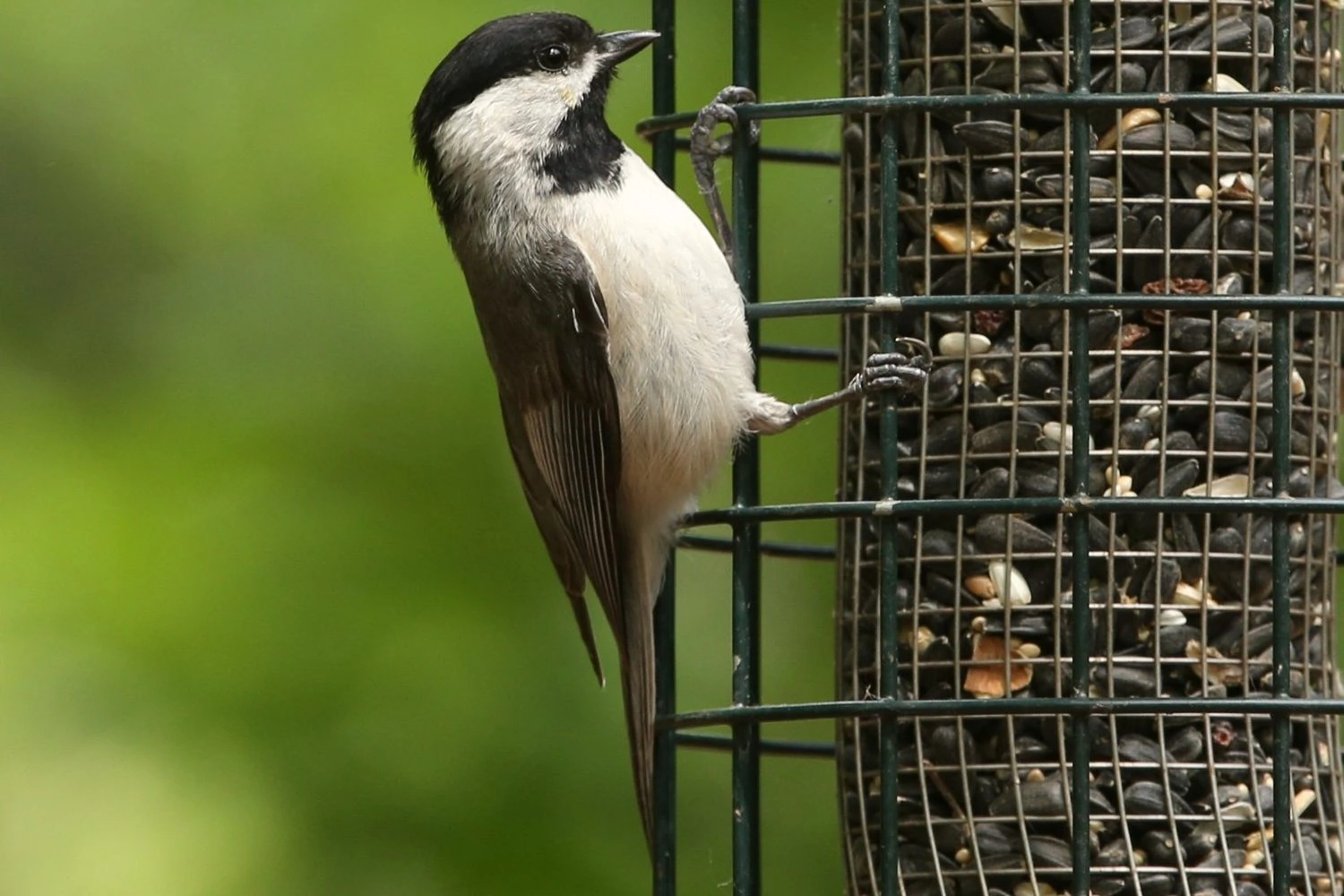
Carolina Chickadees are tiny birds with large heads, black caps and necks, white cheeks and bellies, and soft gray backs, wings, and tails.
They are visually very similar to the Black-capped Chickadee, and they interbreed where their range overlaps.
- Poecile carolinensis
- Length: 3.9-4.7 in (10-12 cm)
- Weight: 0.3-0.4 oz (8-12 g)
- Wingspan: 5.9-7.9 in (15-20 cm)
Carolina Chickadees can be found in forested areas, parks, and backyards in eastern and southeastern US states all year.
Carolina Chickadee Song:
Attract Carolina Chickadees to your backyard feeders with black oil sunflower seeds, nyjer seeds, suet feeders, or peanuts. They will feed on most types of feeders, including tube feeders, suet cages, or platform feeders. They will also nest in nest boxes or nest tubes.
8. Eastern Phoebe
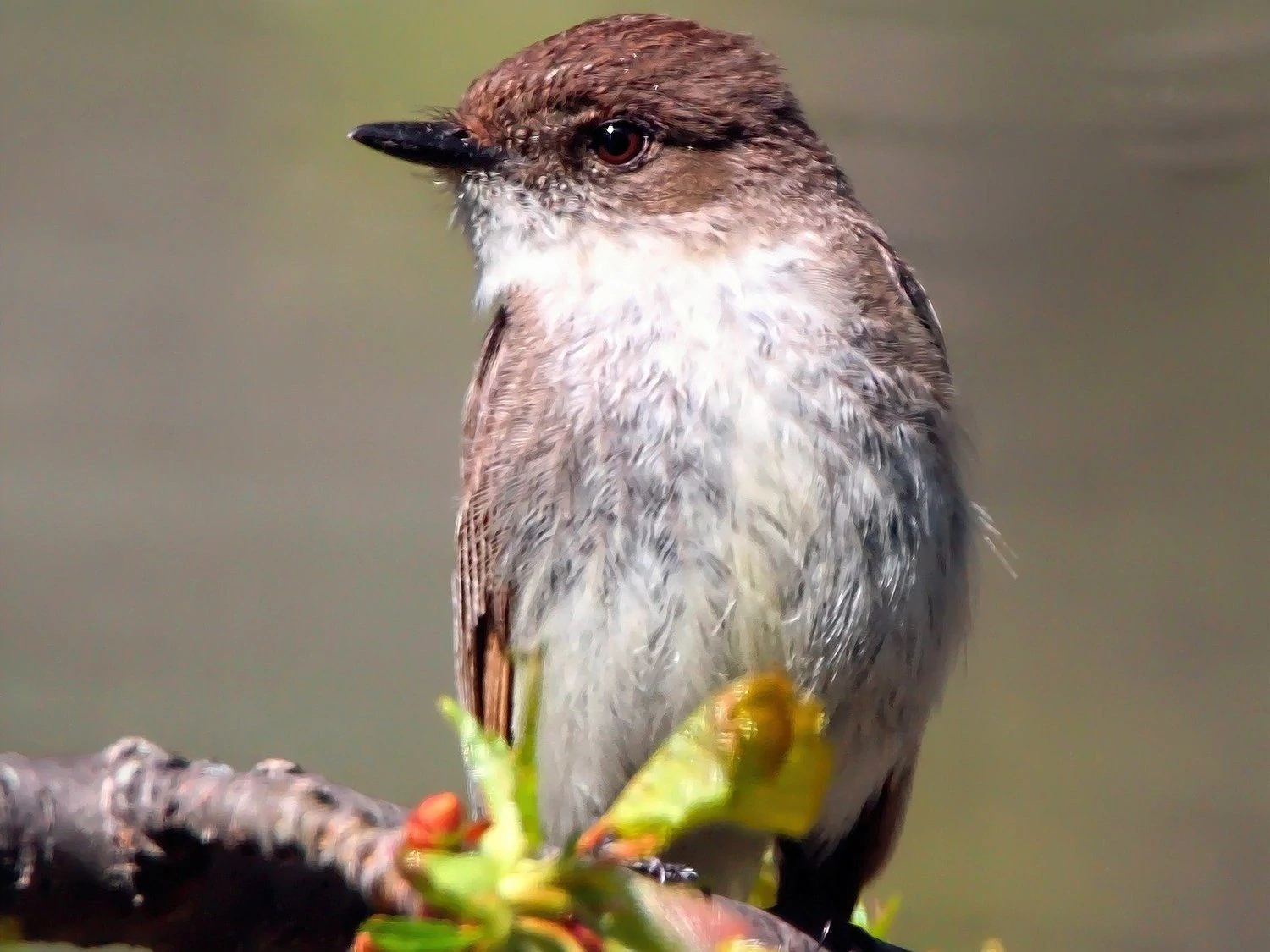
Eastern Phoebes are plump songbirds that are grayish-brown on the back and whitish underneath and with a darker head.
- Sayornis phoebe
- Length: 5.5-6.7 in (14-17 cm)
- Weight: 0.6-0.7 oz (16-21 g)
- Wingspan: 10.2-11.0 in (26-28 cm)
Eastern Phoebes are migratory birds, breeding across northeastern and central US states and into Canada before migrating to southeastern US states and Mexico for winter. Some birds may remain all year towards the south of their range.
Eastern Phoebes tend to be found alone in quiet woodland, wagging their tails from low perches rather than in pairs or flocks.
As they are flycatchers, flying insects make up the most of their diet, but they will also eat spiders and other insects, small fruit, and seeds. They often nest on bridges and barns or houses, making a nest out of mud and grass.
Eastern Phoebe Song:
Attract Eastern Phoebes to your backyard by putting up a nest box or native plants that produce berries.
9. Great Blue Heron
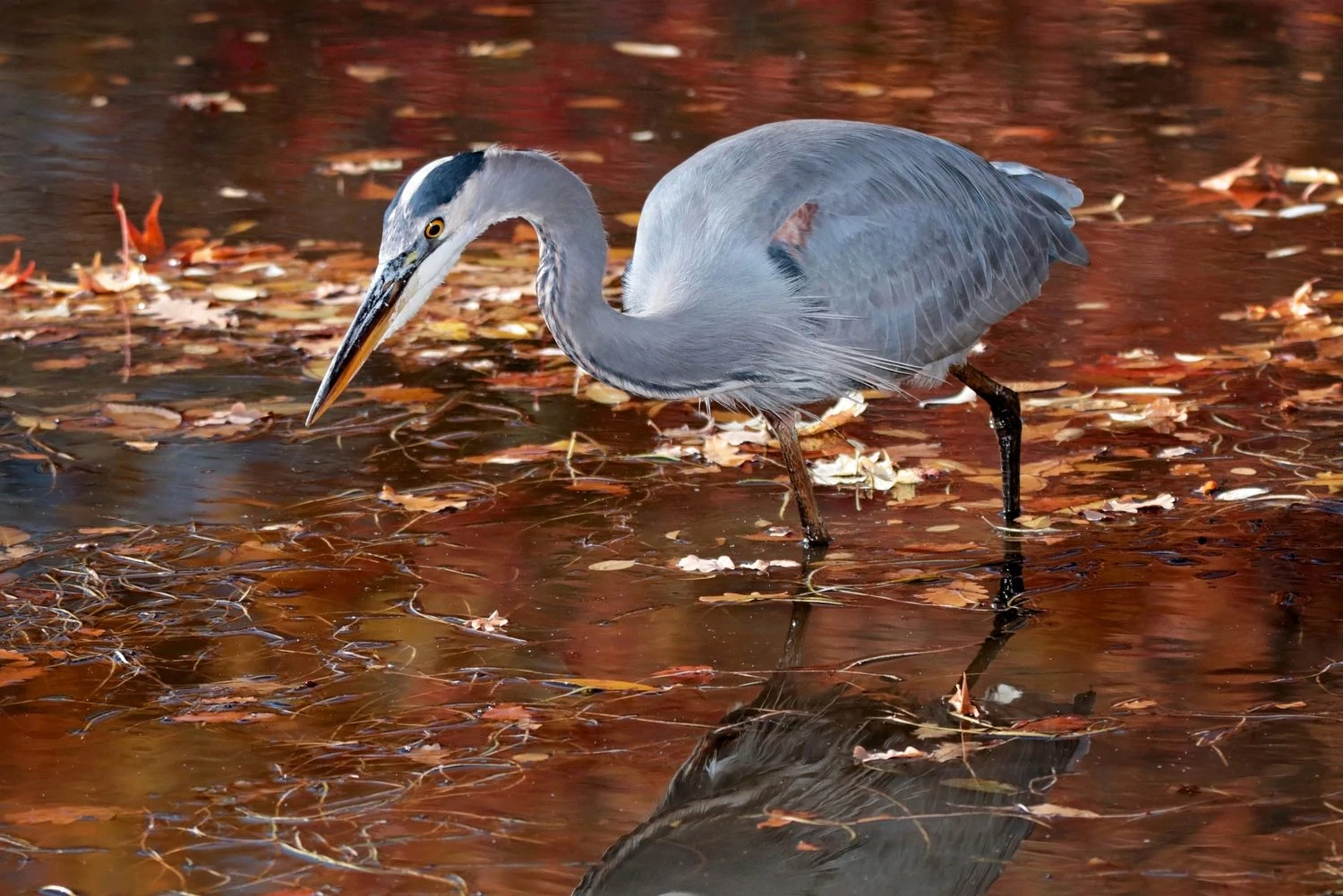
Great Blue Herons are very large, majestic birds that are the largest heron native to North America.
They have a white face with a black crest or plume that extends from the front of their eyes to the back of their heads. Their bills are yellow-orangish.
They have long gray necks with black and white streaking in the front, grayish-blue bodies, and long gray legs.
- Ardea herodias
- Length: 46 – 52 in (117 – 132 cm)
- Weight: 128 oz (3628 g)
- Wingspan: 77 – 82 in (196 – 208 cm)
Great Blue Herons remain in most US states all year, but those that breed in the Mid-West and Canada migrate south.
The Great Blue Heron has a white morph subspecies called the Great White Heron in Florida.
You can find Great Blue Herons in many wetland environments. They can be present in fresh and saltwater marshes, mangrove swamps, flooded marshes, lake edges, or shorelines.
Great Blue Herons’ main diet consists of fish, frogs, salamanders, shrimps, crabs, dragonflies, grasshoppers, and other aquatic insects.
They capture their prey when wading or standing in water. They may also hover over water, dive into the water, jump feet-first from perches, or float on the water’s surface.
Great Blue Heron Call:
Fun Fact: Great Blue Herons defend their feeding territory with dramatic wing outstretched displays, with their heads thrown back.
10. Carolina Wren
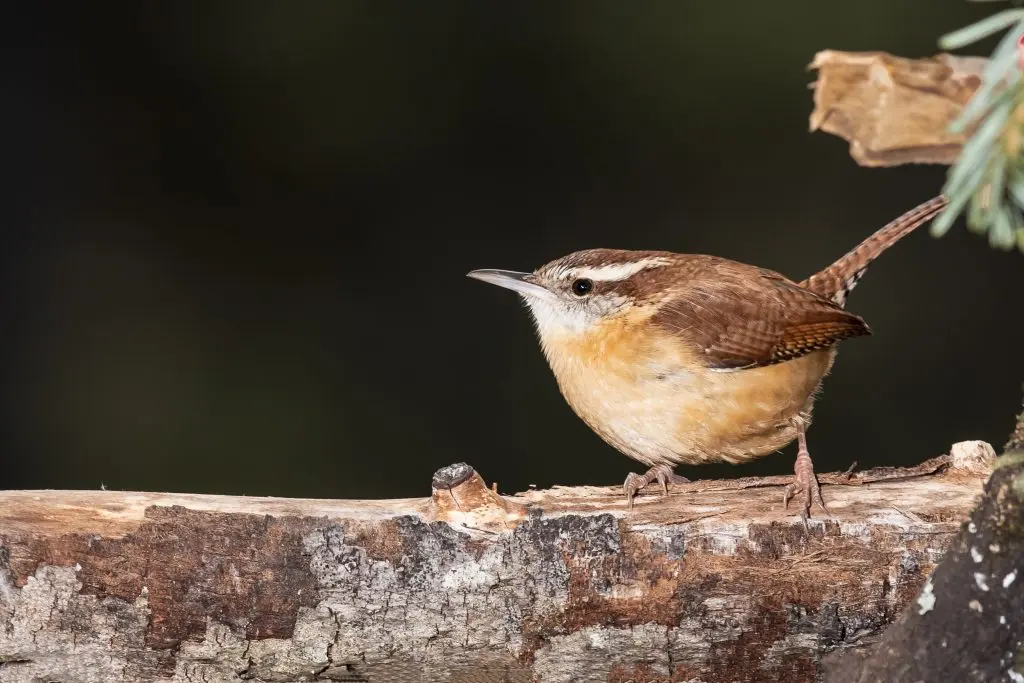
Carolina Wrens are shy birds that are dark brown on top and light brown underneath. They have a white eyebrow stripe and upright tail, and a loud ‘teakettle‘ song.
- Thryothorus ludovicianus
- Length: 4.7-5.5 in (12-14 cm)
- Weight: 0.6-0.8 oz (18-22 g)
- Wingspan: 11.4 in (29 cm)
Carolina Wrens are residents all year across eastern and southeastern US States.
You can find them in woods or thickly vegetated areas, and they will visit backyard feeders.
Carolina Wren Song:
Attract Carolina Wrens to your backyard feeders with suet feeders, hulled sunflower seeds, or peanut hearts in large tube feeders or on platform feeders.
11. Blue Jay
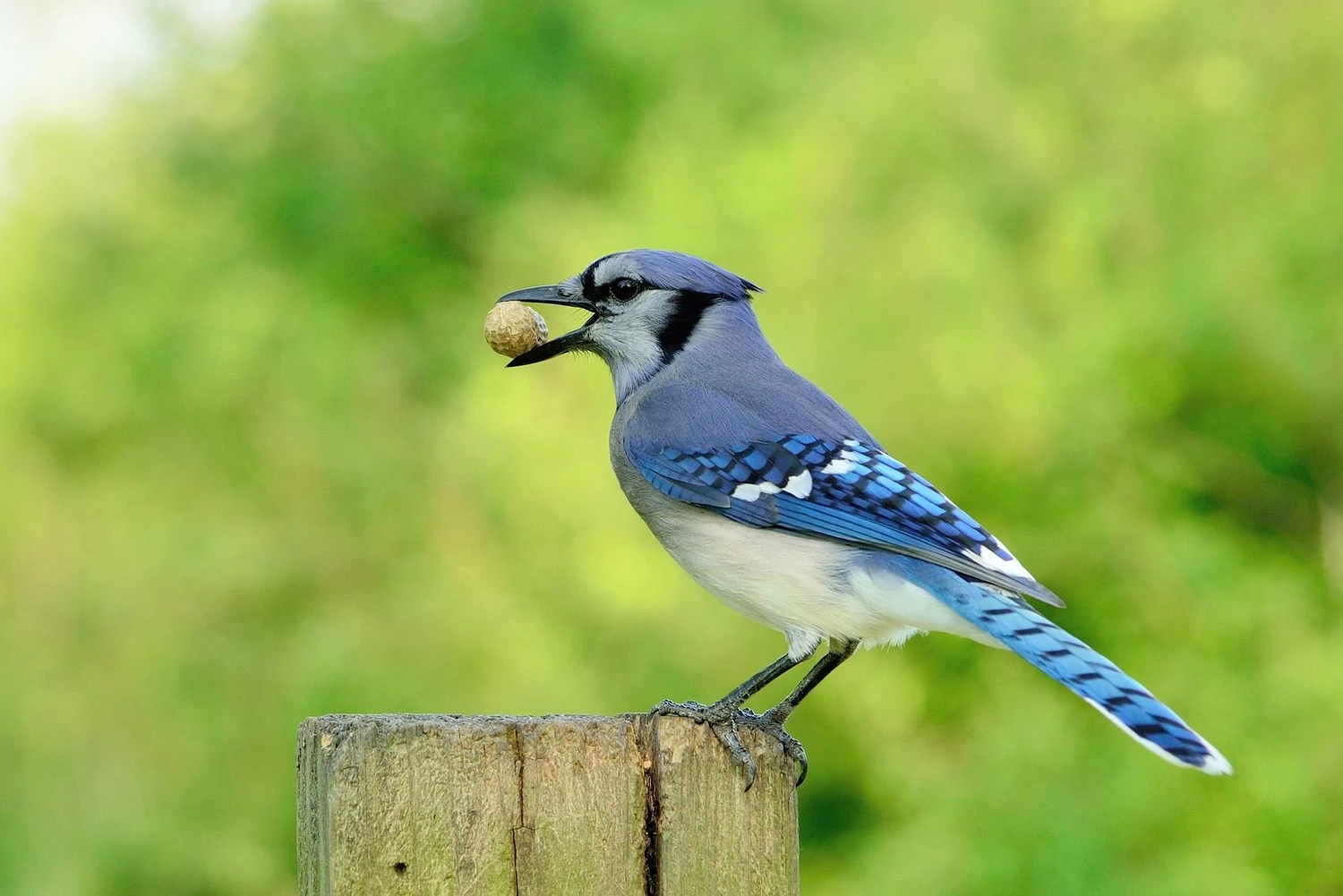
Blue Jays are common large songbirds with a blue upright crest, blue and black backs, and white undersides.
- Cyanocitta cristata
- Length: 9.8-11.8 in (25-30 cm)
- Weight: 2.5-3.5 oz (70-100 g)
- Wingspan: 13.4-16.9 in (34-43 cm)
Blue Jays live in eastern US states and Southern Canada all year. Some birds will migrate west for winter but not very frequently.
They are noisy birds that travel in family groups eating acorns when available. They can be found in forests, mainly near oak, as they eat acorns. They can also be found in backyards near feeders. As well as acorns, they eat insects, nuts and seeds, and grain. They may also take eggs from nests or take nestlings.
Blue Jay Call:
Blue Jays are large birds and prefer to fly in, grab a peanut or sunflower seed and take it away to feed. They prefer platform or tray feeders to make it easy to make a quick exit.
Attract Blue Jays to your backyard with peanuts, sunflower seeds, and suet. They prefer these on open tray feeders or hopper feeders on a post. They will also enjoy a birdbath.
12. White-winged Dove
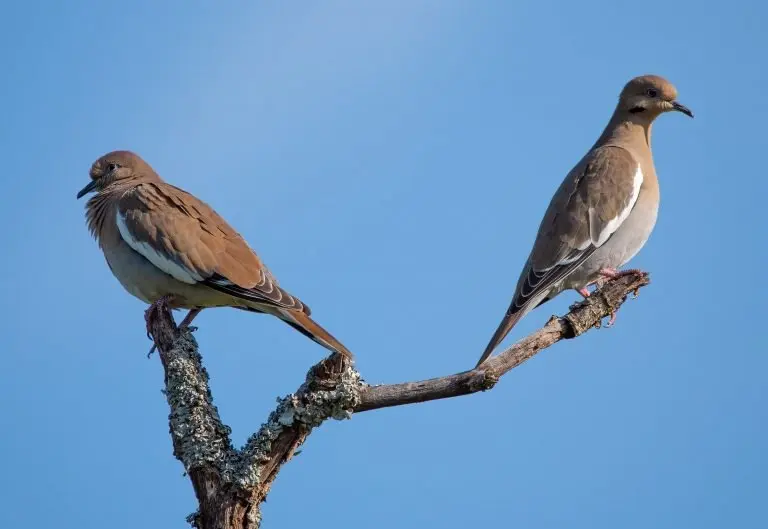
White-winged Doves are pale gray-brown with a black line on the cheek and a white stripe on the edge of the closed wing, which is striking to see on the middle of their dark wing in flight. Males and females look the same.
- Zenaida asiatica
- Weight: 4.4-6.6 oz (125-187 g)
- Wingspan: 18.9-22.8 in (48-58 cm)
White-winged Doves breed along the southern border with Mexico and are resident in Mexico, Central America, and the West Indies. Those to the north of the range may move south towards the Gulf Coast or into Mexico for winter.
You can find White-winged Doves in deserts, dense, thorny forests, woodlands, and suburban areas. Their diet is mostly grain, fruits, and large seeds, and they forage on the ground.
White-winged Dove Call:
Attract White-winged Doves to your yard with sunflower, corn, safflower, and milo on platform feeders. Also, plant native berry-producing shrubs.
13. Great-tailed Grackle
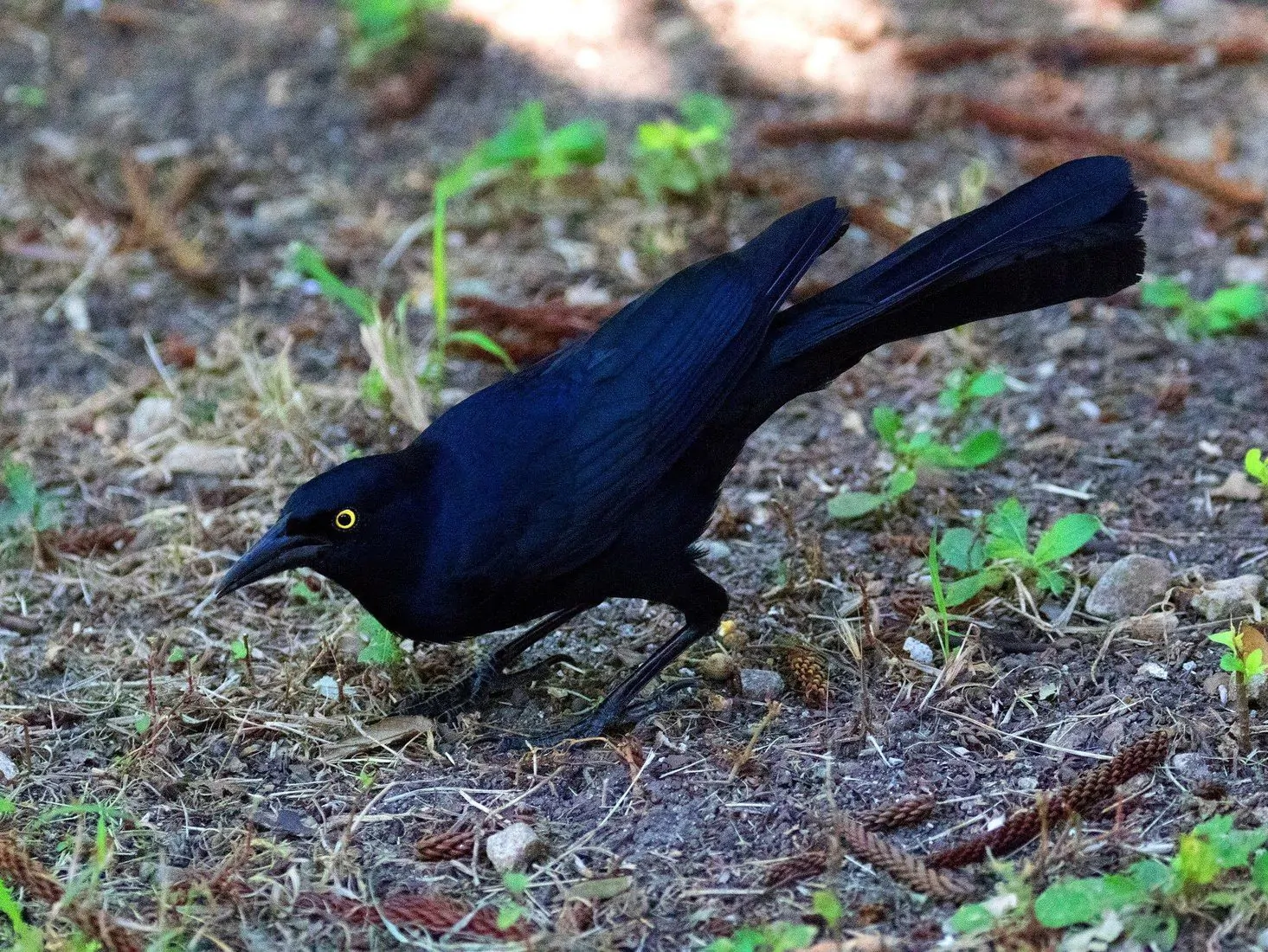
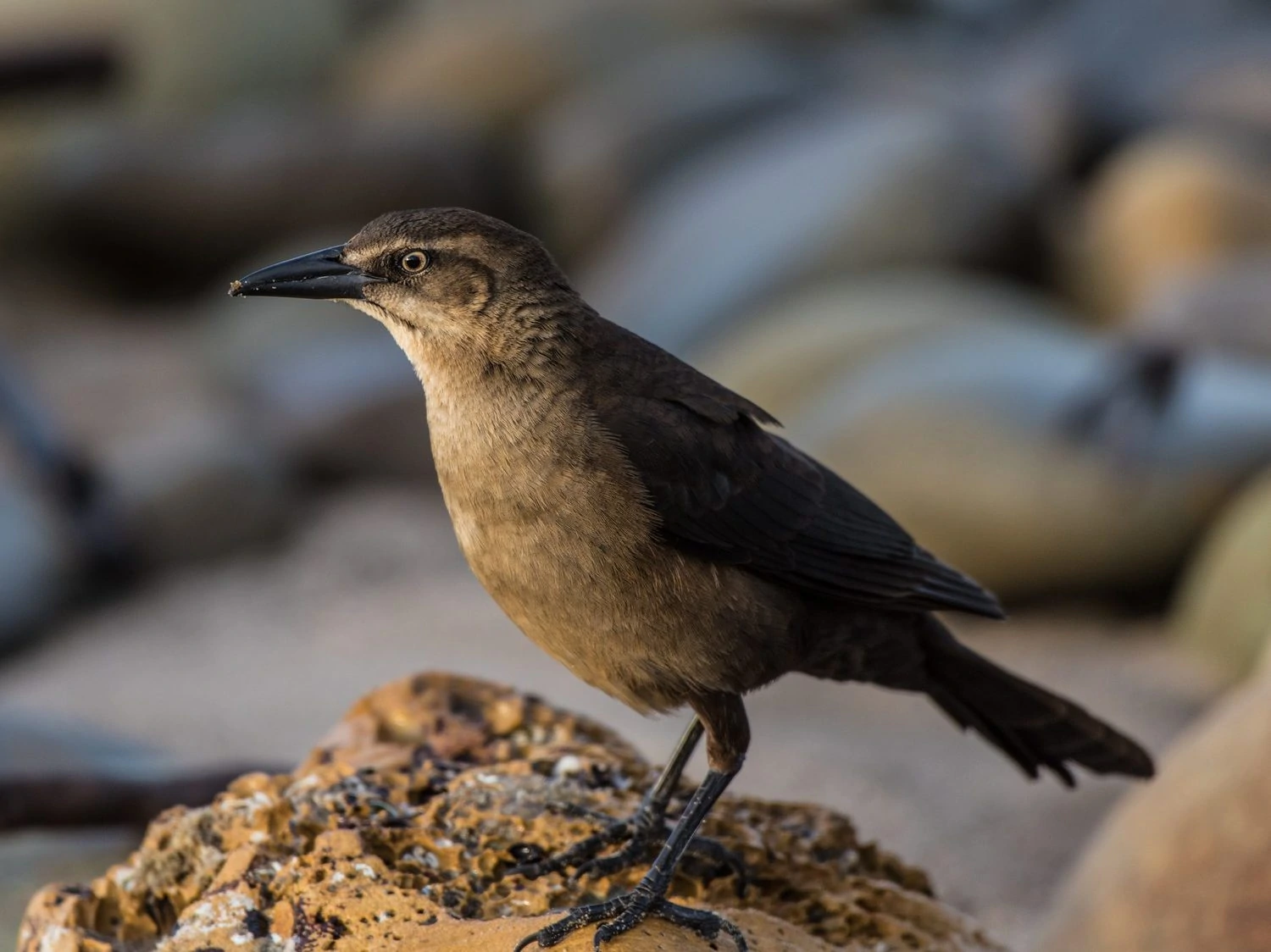
Great-tailed Grackles are long slender blackbirds with impressive long tapered tails in the males. Males are iridescent black with piercing yellow eyes. Females are also long-legged and slender but are dark brown on the back and lighter brown underneath, with more slender tails.
- Quiscalus mexicanus
- Length: 15.0-18.1 in (38-46 cm)
- Weight: 3.7-6.7 oz (105-190 g)
- Wingspan: 18.9-22.8 in (48-58 cm)
Great-tailed Grackles can be found in the West and Midwest in agricultural and urban areas, generally where humans are.
Great-tailed Grackles’ diet is grains, seeds, and fruit, as well as insects and other animals such as worms, beetles, spiders, bees, slugs, and snails. They will also sometimes eat small mammals and lizards as well as eggs and nestlings.
Great-tailed Grackle sounds: They have a fantastic array of whistles, shrieks, and rattles.
Great-tailed Grackles may be seen strutting across your lawn and can be attracted to seed dropping from feeders above. They will also eat black oil sunflower seeds, cracked corn, and millet on platform feeders or large hopper feeders.
Fun fact: Male Great-tailed Grackles are up to 60% heavier than females.
14. Great Egret
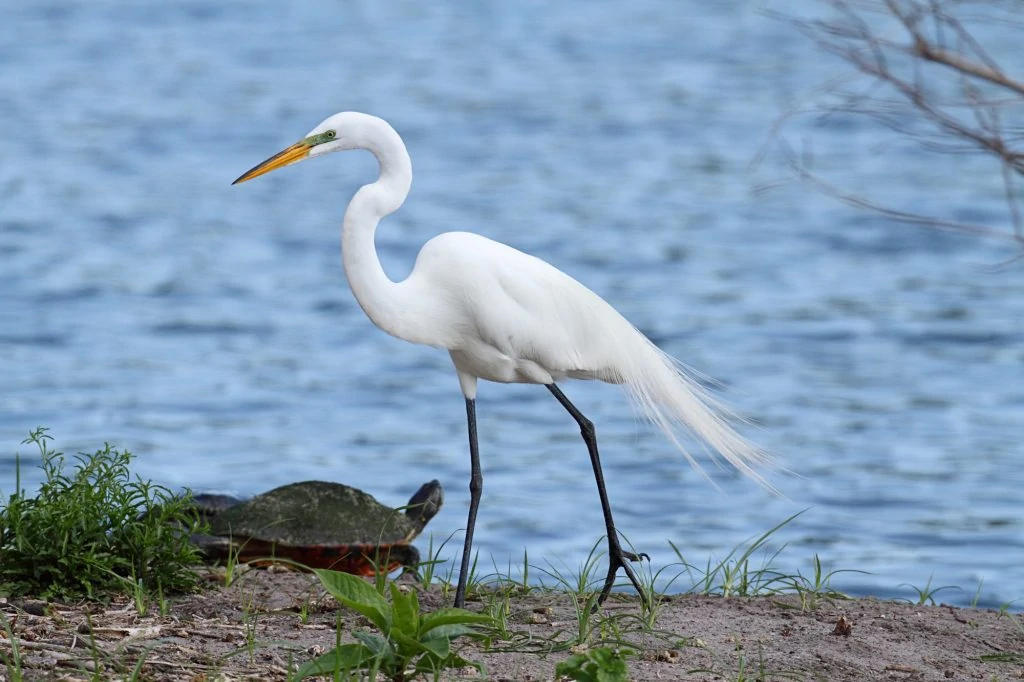
Great Egrets are at their best during the breeding season when males have neon green facial skin and long, wispy feathers (aigrettes) extending from their backs to their tails, which they show off during courtship, like how a peacock flares out its tail.
They are large, all-white herons, which is why they’re often called Great White Herons. They are also called common egrets. These large birds are white, with dagger-like, long, bright yellow bills and long, black legs and feet.
Non-breeding males, females, and juveniles look alike.
- Ardea alba
- Length: 37 – 41 in (94 – 104cm)
- Weight: 59.96 oz (1699 g)
- Wingspan: 54 – 55 in (137 – 140 cm)
Great Egrets have a vast range around the world. Those in the southern and coastal US states remain all year, but those more inland and in Canada migrate south.
You can find Great Egrets in freshwater and saltwater marshes and tidal flats, but also fish ponds.
The diet of Great Egrets consists mainly of fish, frogs, small mammals, crustaceans, and insects. You will see Great Egrets standing motionless on the water, waiting and scouting their prey, and then they strike and spear it with their long bills.
Great Egret Calls:
Fun Fact: The Great Egret was almost hunted to extinction because of their long white feathers (aigrettes) that were mainly used to decorate ladies’ hats.
15. Red-winged Blackbird
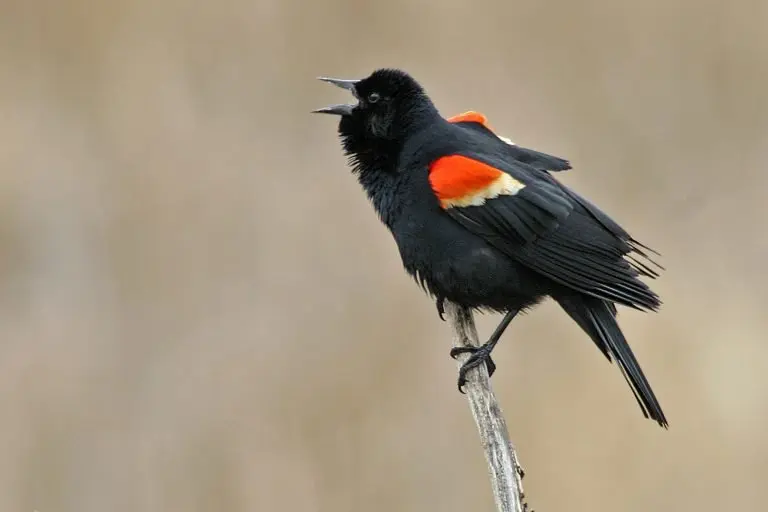
Red-winged blackbirds are very common and easy to identify with the all-black coloring except for the reddish-orange wing patches. Females are rather dull in comparison with streaky brown color.
- Agelaius phoeniceus
- Length: 6.7-9.1 in (17-23 cm)
- Weight: 1.1-2.7 oz (32-77 g)
- Wingspan: 12.2-15.8 in (31-40 cm)
Red-winged Blackbirds remain all year in the lower 48 and the Pacific Coast of British Columbia. Those that breed in Canada and some northern US states migrate south for the winter.
They can often be spotted sitting on telephone wires, and the males will fiercely defend their territories in the breeding season, even attacking people that get too close to their nests. In winter, they roost in large numbers into the millions.
Red-winged Blackbird Song:
Red-winged Blackbird Calls:
Attract Red-winged blackbirds to your backyard with mixed grain and seeds spread on the ground. They will also feed from large tube feeders or platform feeders.
16. Black Vulture
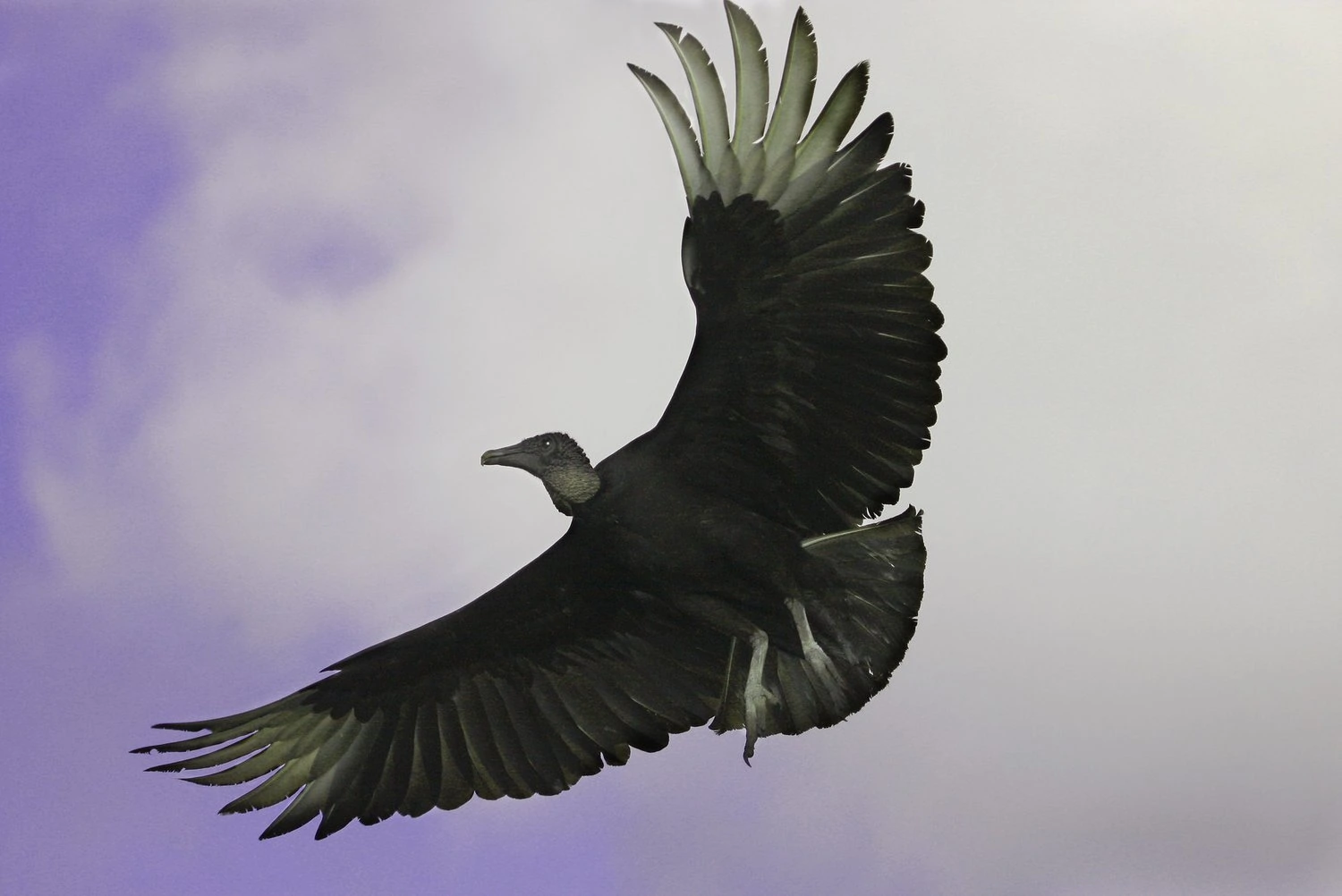
The body of the Black Vulture is black. They’re considered the blackest of all the vultures. Their backs, wings, breasts, bellies, and tails are black, although they have silvery patches on the underside of their wings that make it look like they have fingers when in flight. Their eyes are brown and they have grayish-white legs.
The Black Vulture has a gray, featherless head and neck that look like wrinkled skin.
Black Vultures are “bald” out of necessity because it needs to stick its head into the bodies of dead animals to get to their juiciest parts. Having feathers on their heads will make it hard for them to clean themselves up when bits and pieces of the carrion stick to the feathers.
The Black Vulture is also commonly called American Black Vulture but is not its official name. It’s only meant to distinguish it from the Eurasian Black Vulture, Aegypius monachus.
- Coragyps atratus
- Length: 23 – 27 in (58 – 69 cm)
- Weight: 76.8 oz (2177 g)
- Wingspan: 54 – 60 in (137 – 152 cm)
You can find Black Vultures in open areas of lowland and middle elevations. They are often seen in forested landscapes and roost in wooded areas that are close to water. Other habitats include shrublands, grasslands, swamps, and pastures, and they are even sighted in human-occupied towns foraging in trash cans and garbage dumps.
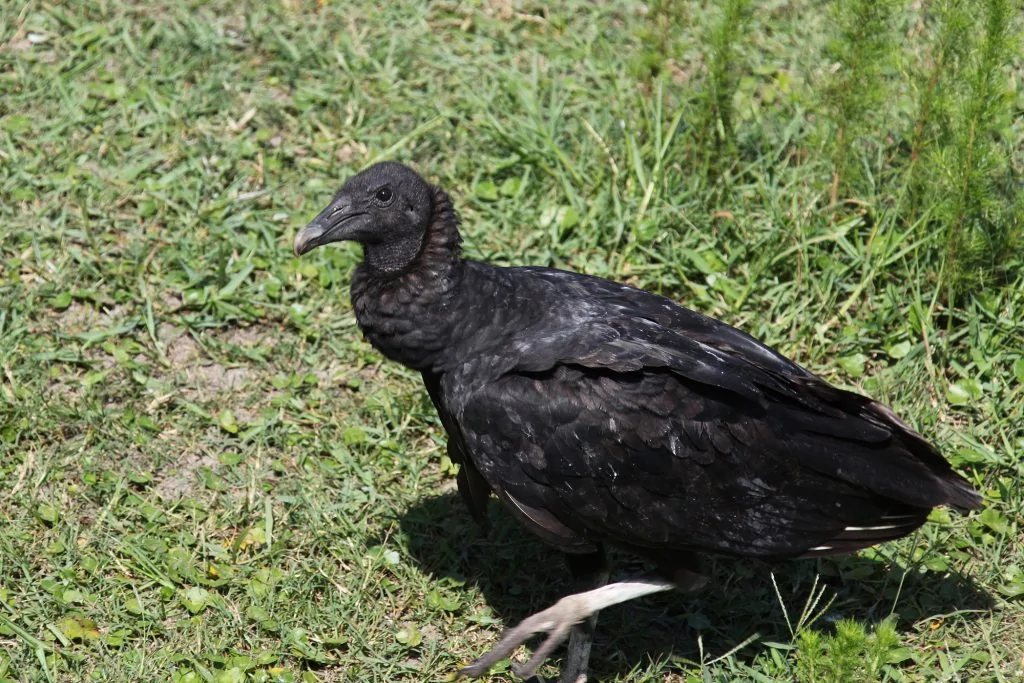
Black Vultures eat practically anything, but mainly they eat carrion or decaying animals. They may be able to see dead animals on the ground themselves, but they usually rely on other scavenger birds to direct them towards food.
They eat small to large-sized dead poultry, raccoons, coyotes, snakes, and even floating fish. They also kill small or vulnerable animals like newborn calves, lambs, and tortoises and spend time at the dumpsters and landfills rummaging among the trash.
Black Vultures Calls: They do not make many sounds and instead have a deep ‘coo’ grunt.
Black vultures form strong social bonds such that they have communal roosts and they share food among relatives. They’re extremely selective about non-relatives joining in the communal roosts and will attack those who will try.
Fun Fact: The Black Vulture has a keen sense of sight but not a keen sense of smell, so it will follow others that have that skill in order to find food.
17. Orange-crowned Warbler
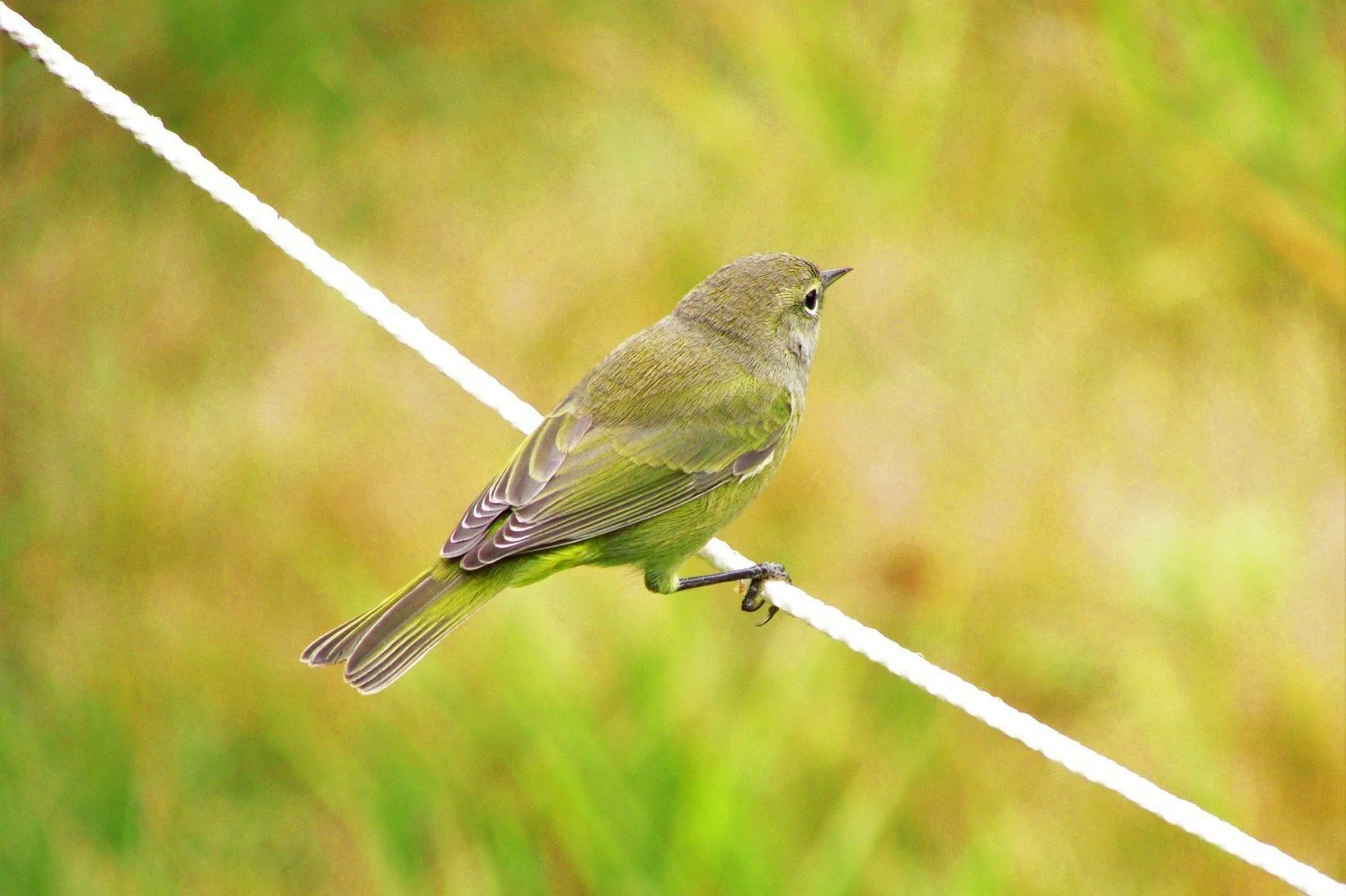
Orange-crowned Warblers are not as brightly colored as other warblers with their yellow-olive coloring. They are more yellow on the Pacific Coast, and the orange crown is rarely seen.
- Leiothlypis celata
- Length: 4.3-5.5 in (11-14 cm)
- Weight: 0.3-0.4 oz (7-11 g)
- Wingspan: 7.5 in (19 cm)
Orange-crowned Warblers breed in Canada and western US states before migrating to the Pacific, East Coast, Gulf Coast, and Mexico. However, Orange-crowned Warblers can also be seen during migration across all states.
You can find Orange-crowned Warblers in shrubs and low vegetation, and they breed in open woodland.
Orange-crowned Warblers eat mainly insects, spiders, caterpillars, and flies. However, they will also eat fruit, berries, and seeds and regularly visit backyard feeders.
Orange-crowned Warbler Song:
Attract more Orange-crowned Warblers to your yard with suet and peanut butter or hummingbird feeders with sugar water nectar.
18. House Sparrow
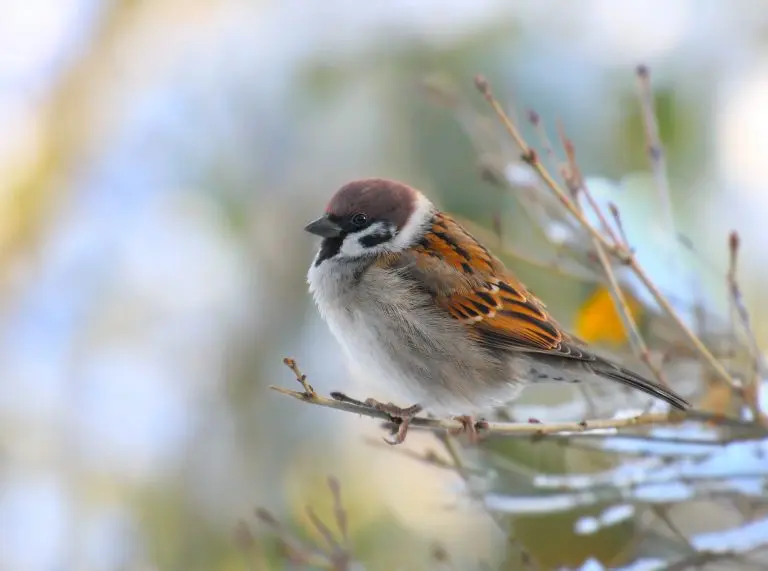
The House Sparrow is another introduced species that has done very well and is now one of the most common birds. They have gray and brown heads and white cheeks. Their backs are black and brown, and their bellies are gray.
- Passer domesticus
- Length: 5.9-6.7 in (15-17 cm)
- Weight: 0.9-1.1 oz (27-30 g)
- Wingspan: 7.5-9.8 in (19-25 cm)
House Sparrows live in the US and Southern Canada all year.
You can find them near houses and buildings, and they can be pretty tame, and they may even eat out of your hand.
House Sparrows eat mostly grain and seed as well as discarded food. They can be considered a pest because they are non-native, but they are found in backyards even if you do not feed them.
House Sparrow Song:
Attract House Sparrows to your backyard feeders with most kinds of birdseed, including millet, corn, and sunflower seeds.
19. Red-tailed Hawk
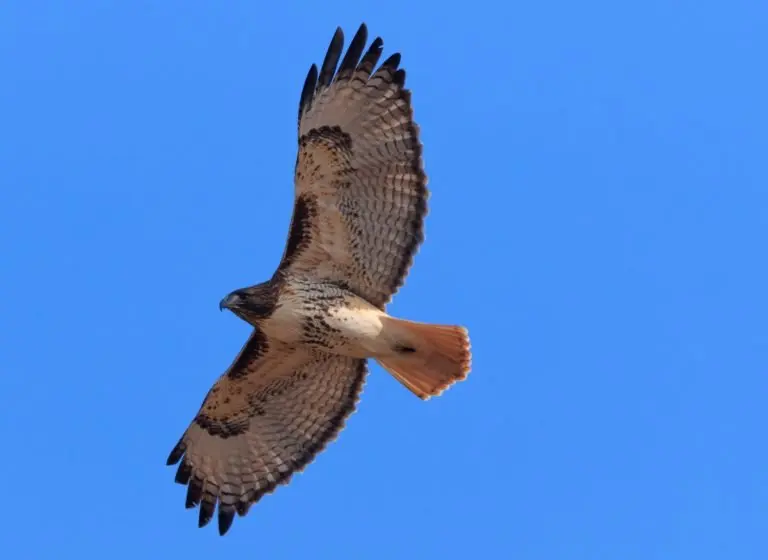
As their name suggests, Red-tailed Hawks have a distinctive short, wide red tail. They are large, with broad, rounded wings. Most Red-tailed Hawks are brown on the back and pale underneath.
They are also the easiest to spot, often on long car journeys, as they circle slowly over open fields looking for prey such as small mammals, birds, and reptiles. You can also see them perched on telephone poles.
Male
- Length: 17.7-22.1 in (45-56 cm)
- Weight: 24.3-45.9 oz (690-1300 g)
- Wingspan: 44.9-52.4 in (114-133 cm)
Female
- Length: 19.7-25.6 in (50-65 cm)
- Weight: 31.8-51.5 oz (900-1460 g)
- Wingspan: 44.9-52.4 in (114-133 cm)
Red-tailed Hawk Call:
The high-pitched descending raspy-screech sound of the Red-tailed Hawk is often used in movies for all birds of prey.
Red-tailed Hawks remain resident in the US and Mexico, but those birds in Alaska, Canada, and the northern Great Plains fly south for winter.
20. American Goldfinch
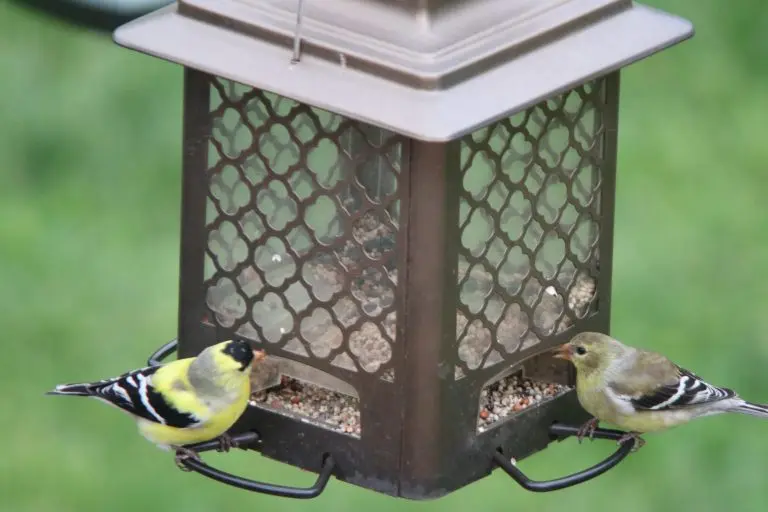
American Goldfinches are popular birds with the males’ bright yellow and black coloring in spring. The females are duller brown, as are males in winter.
- Spinus tristis
- Length: 4.3-5.1 in (11-13 cm)
- Weight: 0.4-0.7 oz (11-20 g)
- Wingspan: 7.5-8.7 in (19-22 cm)
American Goldfinches can be found in most of North America and are usually resident all year. However, those that breed in Canada and the Midwest migrate to southern US States for winter.
They can be found in weedy fields and overgrown areas foraging for sunflower, thistle, and aster plants. They are also common in suburbs, parks, and backyards.
American Goldfinch Song:
Attract American Goldfinches to your backyard by planting thistles and milkweed. They will visit most bird feeders and prefer sunflower seed and nyjer seed.
21. American Crow
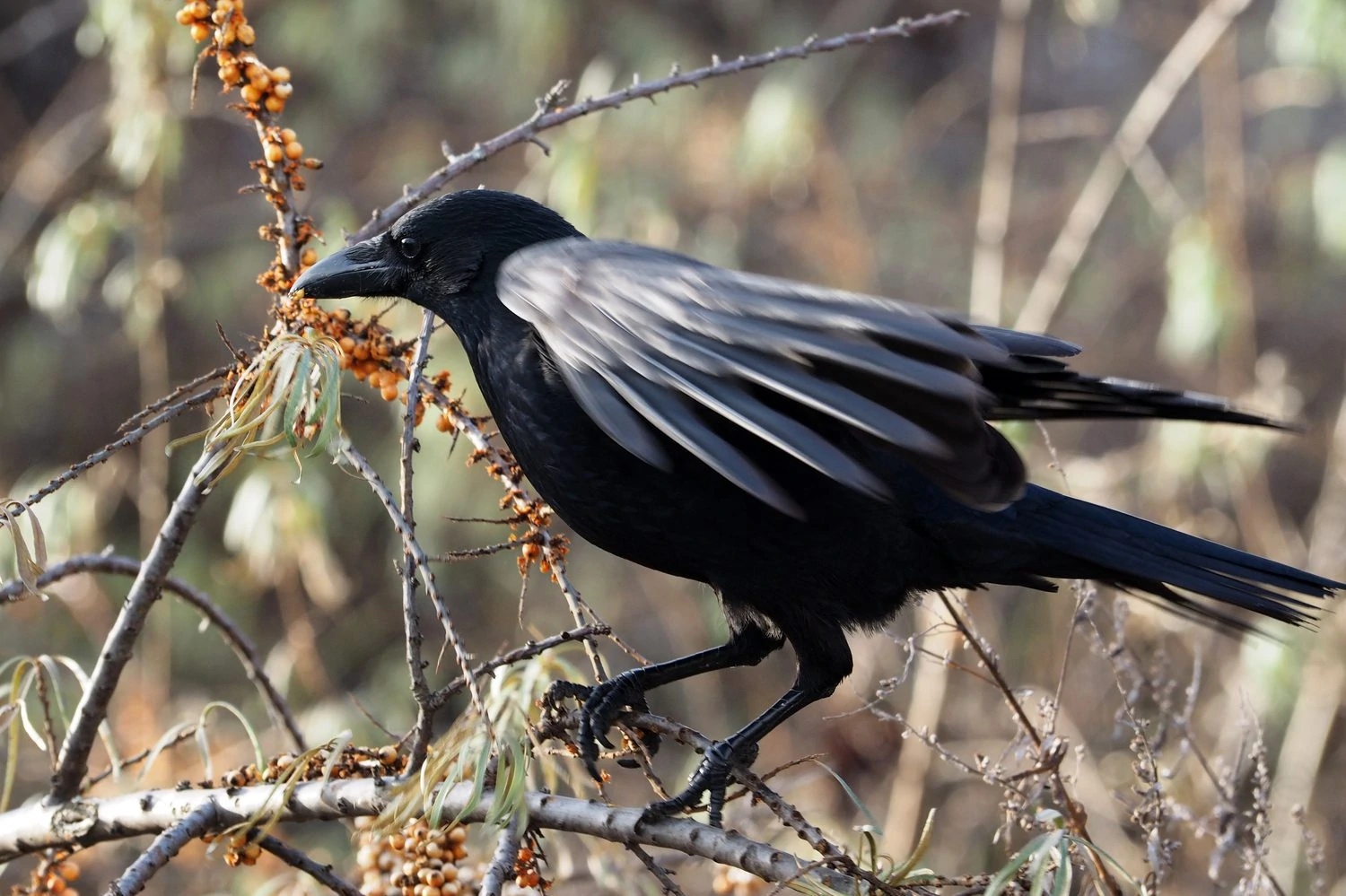
American crows are large all-black birds that make a hoarse, cawing sound.
- Corvus brachyrhynchos
- Length: 15.8-20.9 in (40-53 cm)
- Weight: 11.2-21.9 oz (316-620 g)
- Wingspan: 33.5-39.4 in (85-100 cm)
American Crows are residents all year in most of the lower 48 and the Pacific Coast in Canada and Alaska. Those that breed in Canada and the northern Midwest migrate south for winter.
They are common birds found in most habitats, including treetops, woods, fields, beaches, or towns.
They eat most things and usually feed on the ground, eating earthworms, insects, seeds, and fruit. They also eat fish, young turtles, mussels, and clams and will even eat eggs and nestlings of many species of birds.
In winter, American Crows gather in large numbers of up to two million crows to sleep in noisy communal roosts.
American Crow Call:
Attract American Crows to your backyard by scattering peanuts, but they can become a nuisance as they are attracted by garbage or pet food if left out.
22. American Coot

American Coots are medium-sized waterbirds that may be mistaken for ducks when they’re in the water. But they’re not ducks since they don’t have a duck’s webbed feet.
Instead, their feet are lobed, which allows them to walk on land and swim expertly in water. They are striking birds with their dark gray to black bodies, red eyes, their white frontal shield tipped with red, and white bills with a black ring around the tip.
Juvenile American Coots have light brown crowns and pale gray bodies.
- Fulica americana
- Length: 15 in (38 cm)
- Weight: 25.6 oz (726 g)
- Wingspan: 23 – 28 in (58 – 71 cm)
American Coots that breed in northern US states and Canada migrate to southern US states and Central America. Those in southern and western US states remain all year.
You can find American Coots in general wetlands like marshes, lake edges, sluggish rivers, and salt marshes. They also inhabit reservoirs, sewage treatment ponds, and roadside ditches. Breeding locations are usually bodies of water with heavy emergent aquatic vegetation along shorelines.
As American Coots love being in the water, their food is usually sourced from diving, like algae and fish. They also eat aquatic plants like water lilies, and cattails in addition to land plants like leaves of trees or grains. They will also catch insects and eat snails, crustaceans, tadpoles, and salamanders.
American Coot Call:
Fun Fact: American Coots display a variety of swimming formations. They may form single-file lines, synchronized swimming, broad arcing formations, and sequential take-off dynamics.
23. European Starling
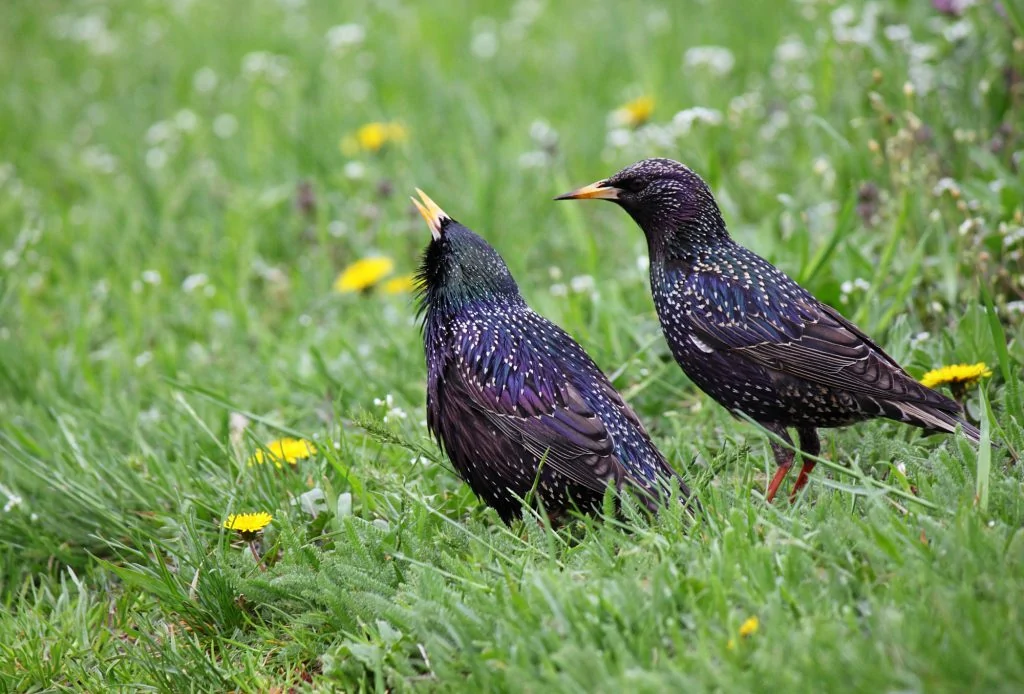
European Starlings are not native but are now one of the most numerous songbirds. They are stocky black birds with iridescent purple, green, and blue tones.
- Sturnus vulgaris
- Length: 7.9-9.1 in (20-23 cm)
- Weight: 2.1-3.4 oz (60-96 g)
- Wingspan: 12.2-15.8 in (31-40 cm)
European Starlings live in all of North America, except the north of Canada and Alaska.
They are considered a pest by some due to their aggressive behavior. These birds fly in large, noisy flocks and can be seen perched in groups on the top of trees or flying over fields.
European Starling Calls:
Starlings predominantly eat insects, including beetles, flies and caterpillars, earthworms, and spiders. However, they also eat fruit, including cherries, holly berries, mulberries, Virginia Creeper, sumac, blackberries, and grains and seeds.
Attract European Starlings to your backyard feeders with black oil sunflower seeds, suet, cracked corn, and peanuts.
24. Double-crested Cormorant
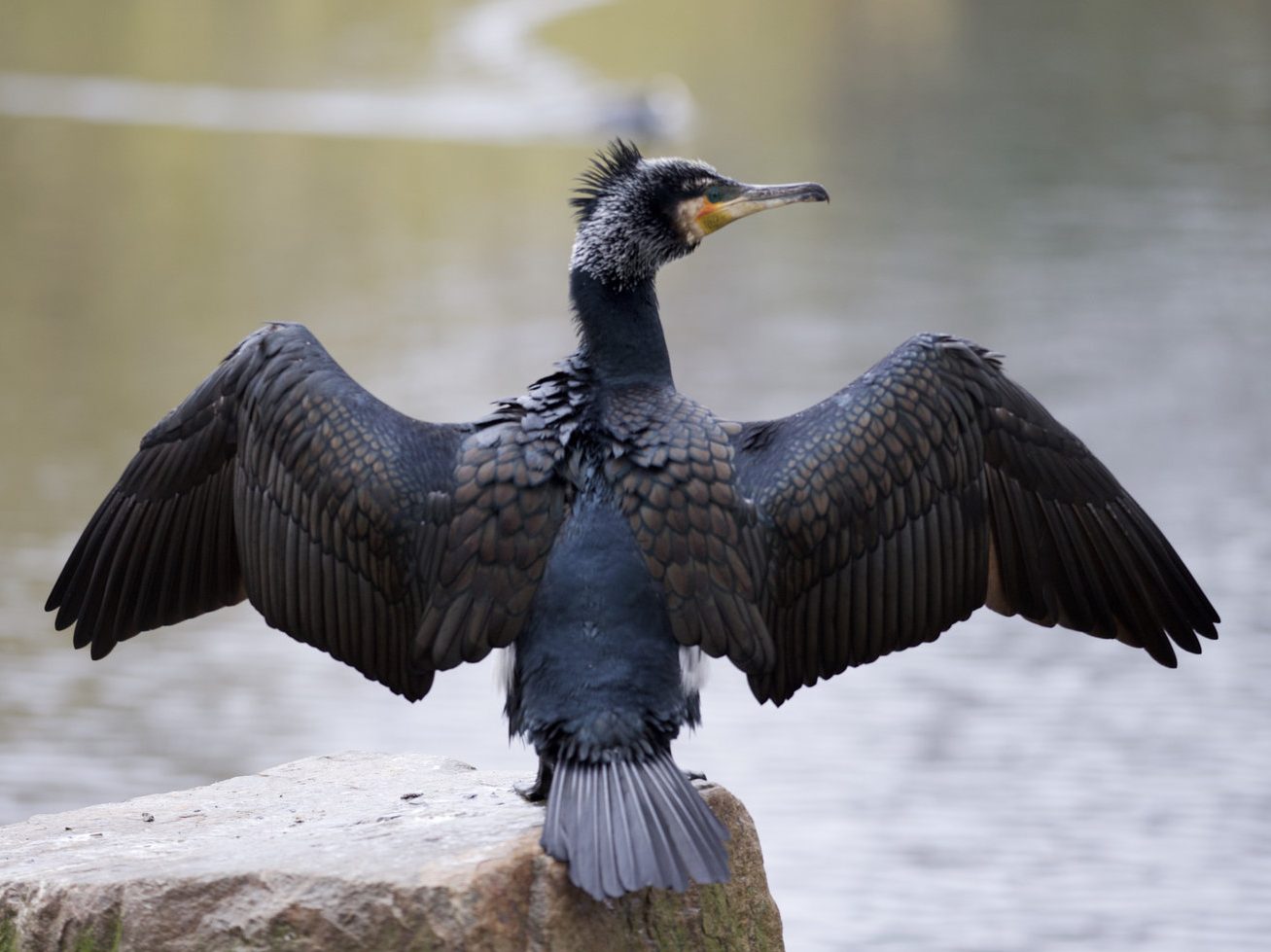
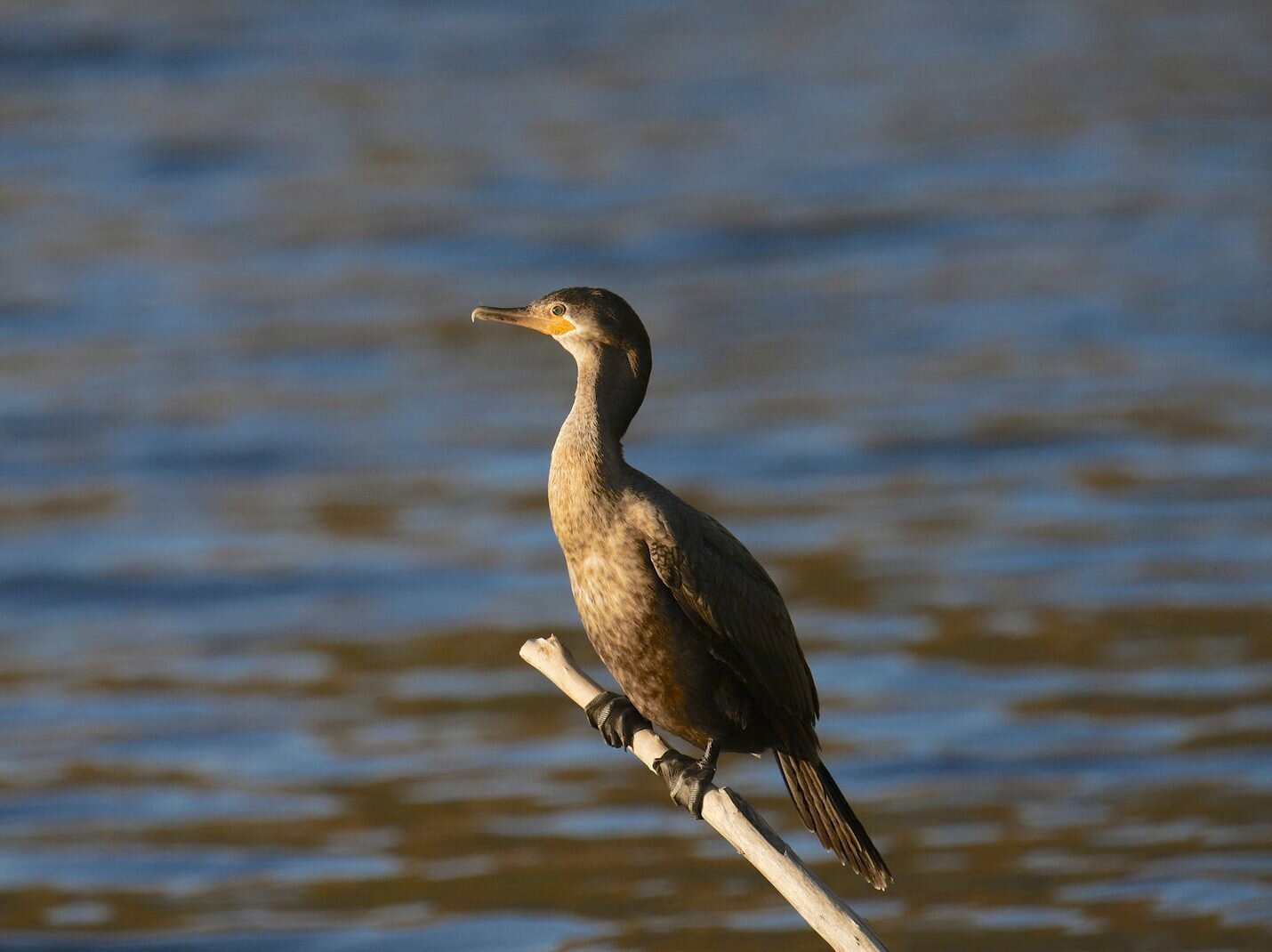
Double-crested Cormorants are large waterbirds that are usually spotted drying themselves with wings outstretched. They are named for the dual crests on their heads which appear during the breeding season. In northwestern birds, these crests are white, but otherwise, they’re black.
Double-crested Cormorants have glossy, black bodies and distinctive yellow-orange skin around the base of the bill and chin. They have black legs and webbed feet. Males and females appear similar.
Juveniles are either grayish or brownish with their underparts paler in color. Their bills are hooked and orange or yellowish, and their upperparts may have a scaled or mottled pattern.
- Nannopterum auritum (formerly Phalacrocorax auritus)
- Length: 32 in (81 cm)
- Weight: 64 oz (1814 g)
- Wingspan: 52 in (132 cm)
Double-crested Cormorants only live in North America. Those that breed inland and the northeast coast migrate to the Pacific coast and southern and southeastern states for winter. However, some remain all year in Florida, Mexico, and the Pacific Northwest coast.
You can find Double-crested Cormorants in aquatic and coastal areas, preferably with an ample supply of fish, like lakes, rivers, swamps, and coasts. They may roost and breed on smaller lagoons and ponds.
Their habitat will have perching areas for drying off where they gather in groups, wings outstretched drying their wings as they are not waterproof.
The diet of Double-crested Cormorants is mainly made up of fish but they can also feed on insects, crustaceans, or amphibians. With their webbed feet, they can dive and chase fish underwater and their hooked bills give them an advantage in catching their prey.
Double-crested Cormorant calls:
Fun Fact: Double-crested Cormorants spend much of their day resting on an exposed perch with their wings spread out. They may be drying their feathers off after diving and fishing.
25. American Kestrel
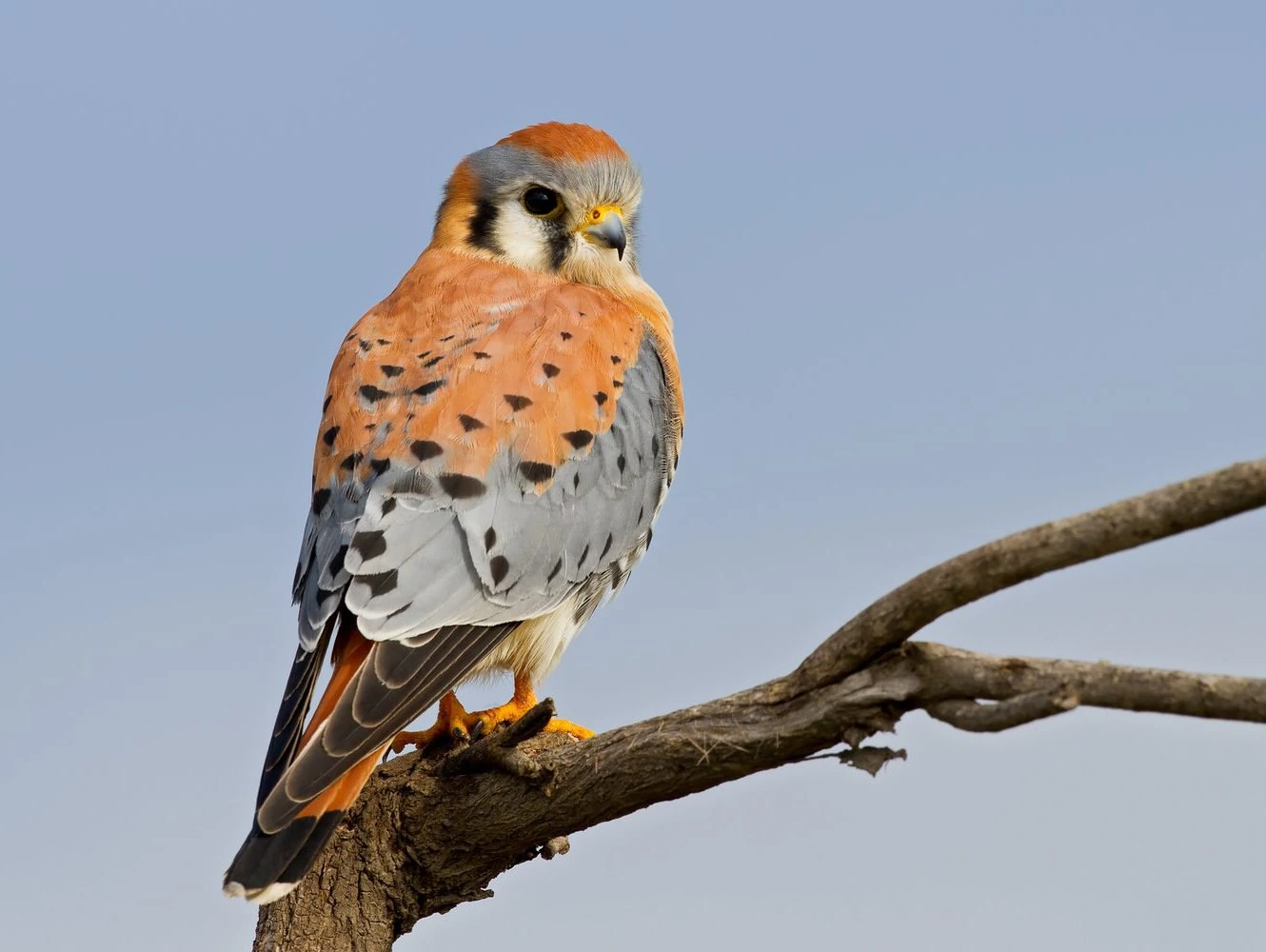
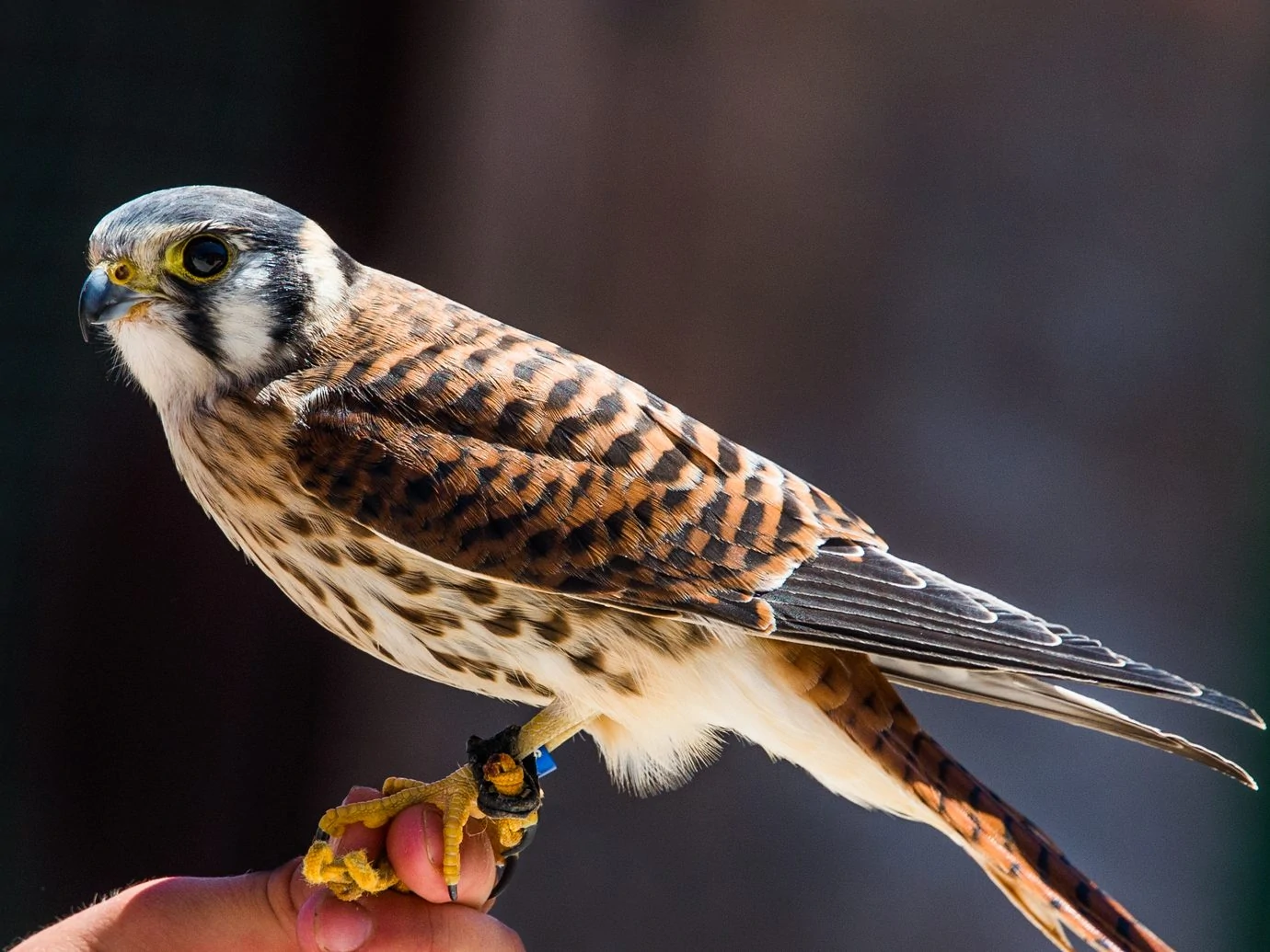
American Kestrels are the smallest and most colorful falcons in North America. Males and females have different colors and markings.
Adult Male American Kestrels are brown and gray and spotted. They have dark gray heads with varying amounts of rufous on the crown, white throats, and unique vertical slashes on their white faces – one under their eyes and another behind their eyes. This is significant because most falcons only have one.
Female American Kestrels are browner and more barred.
- Falco Sparverius
- Length: 9 – 12 in (23 – 30 cm)
- Weight: 3.9 oz (111 g)
- Wingspan: 20 – 25 in (51 – 64 cm)
American Kestrels are the most common falcon with seventeen subspecies living in varied environments and habitats across the Americas. With many subspecies, American Kestrels have plenty of regional variation in their coloring, markings, and vocalizations.
American Kestrels are found in North and South America. Those that breed in Canada migrate south for winter, but the rest remain resident all year.
You can find American Kestrels mainly in open areas without dense cover as they prefer viewing their whole territory from a single perch.
They can hunt and eat grasshoppers, crickets, cicadas, beetles, and dragonflies. What they do is sit and wait on a perch. When they have their prey in sight, they either catch it on the ground or while in flight.
American Kestrels can also hunt by hovering while scanning for prey on the ground.
American Kestrel Call:
Attracting American Kestrels to your backyard is possible if you put up nest boxes that are within their preferred habitats. They need a perch and open area and preferably with no outdoor pets.
Fun Fact: American Kestrels can see using ultraviolet light which comes in handy when trying to hunt their prey. It is especially handy when seeing the trails of urine that are left by voles that allow the American Kestrels to pinpoint their exact location.
Winter vs Summer Birds Texas
There are some birds that stay all year in Texas but many migrate in or out in the spring and fall. These lists give you the most common birds recorded in checklists by bird watchers in summer or winter on ebird.
Winter Birds Texas:
Northern Cardinal 48.46%
Northern Mockingbird 41.38%
Yellow-rumped Warbler 34.81%
Turkey Vulture 29.41%
Mourning Dove 28.18%
Ruby-crowned Kinglet 27.58%
Carolina Chickadee 27.13%
Eastern Phoebe 25.90%
Great Blue Heron 24.39%
Carolina Wren 24.17%
Blue Jay 23.97%
White-winged Dove 23.76%
Great-tailed Grackle 23.76%
Great Egret 22.98%
Red-winged Blackbird 22.52%
Summer Birds Texas:
Northern Cardinal 51.64%
Northern Mockingbird 47.22%
Mourning Dove 45.59%
White-winged Dove 39.16%
Great-tailed Grackle 30.14%
Turkey Vulture 28.79%
Barn Swallow 28.24%
Carolina Wren 28.11%
House Sparrow 28.01%
Blue Jay 27.36%
Carolina Chickadee 26.81%
Great Egret 21.98%
House Finch 21.42%
European Starling 18.78%
Scissor-tailed Flycatcher 18.77%

